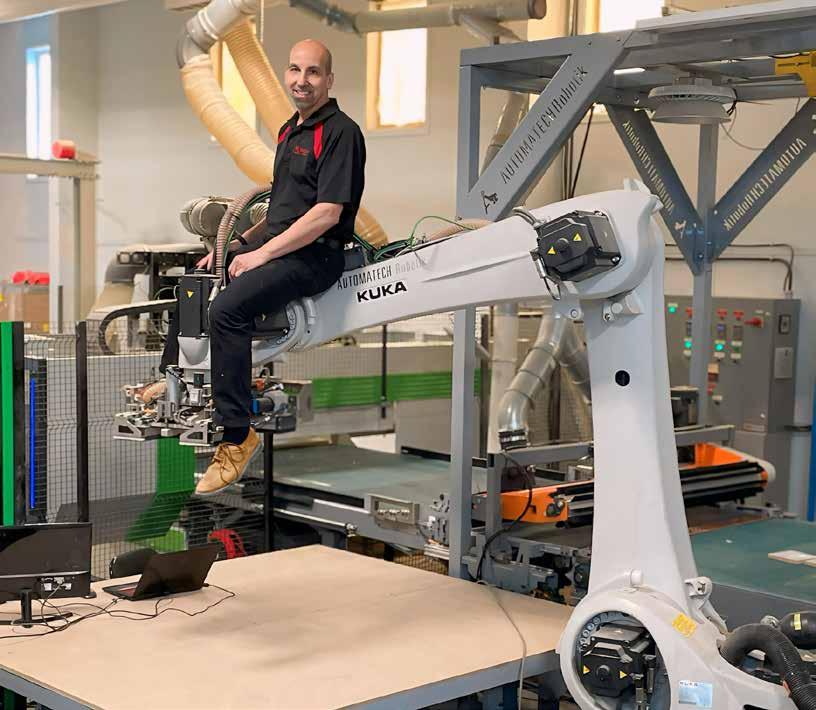
THE BUSINESS SIDE OF WOODWORKING SUMMER 2024 www.woodindustry.ca PM #40063056 THE HUMAN ELEMENT OF INDUSTRY 4.0 LUKE ELIAS MUSKOKA CABINET CO. MAKING AUTOMATION DECISIONS READY, SET, AUTOMATE!



• Outstanding accuracy over the entire working width
• Durability due to closed linear guide system
• Highest processing quality with 2 synchronized digital servo drives in the X direction
• High acceleration due to vector speed X/Y of 96 m/min
• High flexibility of the clamping equipment positioning thanks to MATRIX table PRO
YOUR SOLUTION www.homag.com | info-canada@homag.com | 1-800-797-8231
For demanding production requirements. CENTATEQ N500 CENTATEQ N-500 The compact nesting machine in gantry design.




SUMMER 2024 CONTENTS 14 BALANCING AESTHETIC QUALITY With Production Practicality in Wood Coatings 24 WHY ARE “JOB RELATIONS” Important to the growth of your business? 36 THE HUMAN CONNECTION CNC Cabinet Inc. 40 WHAT IS COMBUSTIBLE DUST And why should you care? 42 ACCESSIBLE DESIGN For Baby Boomers & the Aging Population 46 WHY DIGITAL PRINTING May Just be the Solution to an Industry Dilemma 48 CONSTRUCTION AND CONSUMPTION 4 From the Editor 6 Fillings 52 Product Showcase 54 Stats & Facts COLUMNS DEPARTMENTS Vol. 20, No. 2 www.woodindustry.ca THE BUSINESS SIDE OF WOODWORKING www.woodindustry.ca THE HUMAN ELEMENT LUKE ELIAS DECISIONS READY, SET, AUTOMATE! Photo Credit: Muskoka Cabinet Company 12 Stages of Implementing Automation in Woodworking A Strategic Overview 20 PLANNING TO AVOID THE MOST Common Automation Pitfalls 28 CUTTING COSTS AND THE CUTTING EDGE Automation with Luke Elias of Muskoka Cabinet 38 BALANCING ACT Integrating the Human Element in Industry 4.0 Automation FEATURES
LET’S MAKE AUTOMATION ACCESSIBLE
 HELLO INDUSTRY PARTNERS,
HELLO INDUSTRY PARTNERS,
Welcome to the Summer 2024 issue of Wood Industry Magazine, where we delve into the transformative realm of automation in woodworking. This edition is focused on the decision-making and implementation processes essential for integrating automation, providing a holistic view that enriches our understanding and practices within the sector.
In “Planning To Avoid The Most Common Automation Pitfalls,” Yohaan Thommy from MNP offers a practical guide for small to medium-sized enterprises embarking on automation. Thommy underscores the strategic approach necessary to leverage automation benefits — improving safety, reducing monotony, and enhancing control — while cautioning against common missteps that could jeopardize financial and operational stability.
The feature on Muskoka Cabinet Company, led by Luke Elias, in “Cutting Costs and The Cutting Edge,” illustrates a successful journey of technological transformation. Since 1989, Elias has transformed the traditional cabinet maker into a leader in manufacturing innovation, demonstrating the power of strategic automation in setting industry benchmarks for efficiency and productivity.
Amrita Bhogal’s “Balancing Act: Integrating the Human Element in Industry 4.0 Automation” addresses the synergy between automation and human input. Bhogal advocates for automation that enhances rather than replaces human capabilities, emphasizing the importance of ongoing training and employee involvement in technological transitions.
Additional insights in this issue include a detailed analysis by Jakub Stachurski on wood coatings, blending aesthetic quality with production practicality, and Sandra Wood’s narrative on community-driven business success at CNC Cabinet Inc.
David Smith’s article, “Why Digital Printing May Just be the Solution to an Industry Dilemma,” highlights digital printing as a sustainable innovation, enhancing aesthetics and environmental responsibility. Concurrently, Lucy Traetto’s “Accessible Design for Baby Boomers & the Aging Population” underscores the need for ergonomic cabinetry solutions, showcasing design innovations that cater to an aging demographic. These contributions emphasize the intersection of sustainability and functionality in woodworking.
As we explore the layers of automation integration in this issue, we underscore its critical role in shaping the future of woodworking. The articles serve as a reminder that while technology drives innovation, strategic planning and human ingenuity are equally essential in achieving sustainable growth and competitive advantage.
Thank you for your continued support of Wood Industry magazine. We encourage you to share your experiences and challenges with us, joining a community dedicated to excellence in every facet of our industry.
Until next time, stay innovative, stay informed.
ART DIRECTOR
PUBLISHER
Mike Neeb miken@mediaedge.ca
EDITOR
Tyler Holt tylerh@mediaedge.ca
PRESIDENT Kevin Brown kevinb@mediaedge.ca
PRODUCTION MANAGER
Ines Louis Inesl@mediaedge.ca
Annette Carlucci annettec@mediaedge.ca
GRAPHIC DESIGNER
Thuy Huynh-Guinane roxyh@mediaedge.ca
CIRCULATION circulation@mediaedge.ca
Wood Industry is published four times an nually, Spring, Summer, Fall, Winter, for the secondary wood products manufacturing and marketing industries in Canada. Subscriptions are free to qualified participants in Canada’s secondary wood processing industry. Subscribe at www.woodindustry.ca. Paid subscriptions rates: $40 to Cana dian addresses, $60 U.S. and foreign, $20 student rate. Please mail payment to Wood Industry, 2001 Sheppard Avenue East, Suite 500, Toronto, Ontario M2J 4Z8 For subscription inquiries, e-mail circulation@mediaedge.ca
© 2024 by MediaEdge Communications All rights reserved. MediaEdge Communications and Wood Industry disclaim any warranty as to the accuracy, completeness or currency of the contents of this publication and disclaims all liability in respect to the results of any action taken or not taken in reliance upon information in this publication. The opinions of the columnists and writers are their own and are in no way influenced by or representative of the opinions of Wood Industry or MediaEdge Communications Published by
2001 Sheppard Avenue East, Suite 500 Toronto, Ontario M2J 4Z8
FROM THE EDITOR ISSN 1715-507X PUBLICATIONS MAIL SALES AGREEMENT #40063056 RETURN UNDELIVERABLE CANADIAN ADDRESSES TO: WOOD INDUSTRY 2001 Sheppard Avenue East Suite 500, Toronto, Ontario M2J 4Z8 2012
Tyler Holt
Features
• Simple to manufacture and assemble with diverse options for combining drawer sides.
• Improved manufacturing productivity with fronts and front pieces always manufactured and assembled in the same way.
• Unique L-shape of cabinet profile for vertical stability with 40/70 kg load capacity.
• Synchronized feather-light glide and high front stability for various applications.

www.blum.com/merivobox
10% off MERIVOBOX April 1 to June 30
quantities last Spring Special
while

Industry Mourns the Untimely Death of James Scarlett in Plane Crash
The wood manufacturing community is mourning after James Scarlett, owner of Scarlett Inc. in Grand Rapids, Michigan, tragically died in a plane crash on April 12th. He was returning from the Wood Industry Conference in Florida when the accident occurred. Scarlett, a pivotal figure in the industry and newly appointed chair of the Wood Industry Association’s executive committee, had taken leadership at Scarlett Inc. from his father, Jim Scarlett. Renowned for his innovation and commitment, he significantly influenced the industry.
Born on April 22, 1978, in Lansing, Michigan, Scarlett graduated from Michigan Technological University with degrees in Mechanical Engineering and Business Administration. Beyond his professional achievements, he was known as a devoted family man, survived by his wife Amanda; sons Tucker and Quinlan; his parents, James and Bonnie; siblings Ryan, Mark, and Kelli; and his dog, Stella. His adventurous spirit and community involvement made him a beloved figure both inside and outside of his industry. His passing is deeply felt, and plans for a memorial to honor his contributions and mentorship are underway.
1974 in Daveluyville, the company has thrived by designing advanced solutions for the secondary wood processing industry. The golden anniversary year will feature festivities for employees and the unveiling of a new logo.
Leadership passed to Pascal Doucet and Danny Pelletier in 2008, who continue the legacy begun by their fathers, Gilles Doucet and Elieude Pelletier. “If there is one thing that we can be particularly proud of, it is the feeling of belonging and the spirit of collaboration that has developed at Doucet over the last 50 years,” says Danny Pelletier. “Coming from all walks of life, our people stick together and succeed together,” he concludes.
Pascal acknowledges the role of exportation in the company’s success, noting that 65% of production is sent to the United States. “Today, we take the time to thank our distributors and customers for their trust over the last 50 years,” he adds.

Nederman Celebrates 35 Years in Canada

is set to celebrate its 50th anniversary in 2024. Founded in
Nederman employees recently gathered in Mississauga at Nederman’s Canadian headquarters to celebrate the industrial air filtration company’s 35th anniversary operating in Canada.
“We are proud to celebrate 35 years in Canada helping manufacturers from a wide variety of industrial segments to create cleaner and safer work environments,” said Michael Catalano, VP of Nederman Canada, “We look forward to continued growth in creating clean air solutions to help create safe workspaces, efficient production and significant environmental benefits.”
Coinciding with Nederman Canada 35th anniversary celebration is the 80th anniversary for Nederman Holding AB, headquartered in Helsingborg, Sweden. Founded by Philip Nederman in 1944, the company became a pioneer in developing solutions for air pollution control inside production facilities, protecting workers health and improving their workplace.
Fabrizio

Anzalone
Welcomed as Head of SCM
North America
Mr. Fabrizio Anzalone recently took over as manager for SCM’s branches in the U.S., Canada, and Mexico. With over 20 years of leadership experience, particularly in the industrial sector, Anzalone has a proven history of driving growth and strategic transformations. In his previous role, he doubled sales revenues at SCM France through astute market strategies and talent management. A graduate in Mechanical Engineering from Turin Polytechnic, Anzalone is well-equipped for his role, aiming to build on his predecessor, Giuseppe Riva’s successes by expanding SCM Group’s market presence and fostering new partnerships and technologies in North America. Anzalone expressed his commitment to continuing SCM’s path of success in this crucial market.

Patrick Shannon Joins
MasterBrand’s Board of Directors
MasterBrand, Inc., North America’s leading residential cabinet manufacturer, has appointed Patrick Shannon to its Board of Directors. This immediate addition strategically enhances the board with Shannon’s extensive financial and operational expertise.
Dave Banyard, President and CEO of MasterBrand, welcomes Shannon,
6 WOOD INDUSTRY SUMMER 2024
50 years in the making for Doucet Machineries Inc. Doucet Machineries Inc.
FILINGS








particularly noting his significant experience with corporate spinoffs and the building products industry. Shannon, formerly the Senior Vice President and Chief Financial Officer at Allegion plc, played a crucial role there following its 2013 spin-off from Ingersoll Rand until 2022. His tenure at Ingersoll Rand and leadership positions at OneCoast Network Holdings and AGCO Corporation underline his capacity to drive financial and operational success. Shannon, who holds a BBA from the University of Georgia and an MBA from Mercer University, also serves on the board of directors for Astec Industries since 2024. His appointment is expected to greatly benefit MasterBrand’s strategic direction, market position, and operational efficiency as the company continues to grow and compete in the building products sector.

Introducing Barry Kellar as President of Stiles Machinery
Stiles Machinery is excited to welcome Barry Kellar as its new President, overseeing all North American operations of the HOMAG Group, which includes Stiles Machinery, HOMAG Canada, and HOMAG Machinery North America. Dr. Daniel Schmitt, CEO of the HOMAG Group, expressed his enthusiasm for Kellar’s appointment, noting his extensive manufacturing expertise and leadership qualities that are set to enhance Stiles’ position as a market leader.
Kellar, a graduate of the United States Military Academy at West Point with a degree in Mechanical Engineering, has a distinguished career that began in the US Army in 1986.

Unleash the Power and Precision.
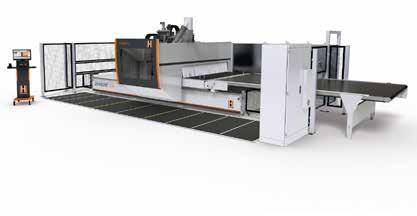
His professional journey includes significant roles at GE Plastics, Hercules Aerospace, Lincoln Composites, and Freudenberg Nonwovens. Most recently, he served as President and CEO for North America at Freudenberg Filtration Technologies and as Global Vice President of Automotive Filtration.
Kellar is committed to supporting Stiles Machinery’s growth by providing top-tier sales and service, leveraging HOMAG’s global reputation and customer-centric approach to deliver exceptional value to customers.

Andreas Böhm is the new Managing Director of VOLLMER
Andreas Böhm has been appointed as the new Managing Director of VOLLMER, the Biberach-based sharpening specialist, succeeding Dr. Stefan Brand and Jürgen Hauger. With over 25 years at Liebherr Group, including more than a decade on the Board of Directors of Liebherr-International AG, Böhm brings extensive international experience in mechanical engineering.
“I am eager to leverage my experience to advance VOLLMER as a global, innovative partner in the tool industry,” says Böhm. He has held various management roles across China, Ireland, and Germany, and served on the Board of Directors for Liebherr’s holding company in Switzerland until 2022.

Böhm is committed to maintaining VOLLMER’s family-oriented tradition while addressing international challenges. The VOLLMER Group aims to continue its legacy as a leading technology and service company.
Martin Kapp, VOLLMER Supervisory Board Chairman, expresses confidence in Böhm’s leadership: “We are delighted that VOLLMER is getting a managing director who will uphold the company’s 115-year tradition.”
8 WOOD INDUSTRY SUMMER 2024
FILINGS
• 5-Axis CNC Machine WEINIG HOLZ-HER CANADA 800.361.9367 | www.holzher.ca • High-Flow Nesting Table • 10 Year Guarantee on All Linear Guide Rails • Automation Components • Solid Gantry Design • 2,200 mm Deep Grid Table


BRANDS OF DISTINCTION


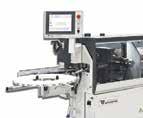


E550CRT – Automatic edge bander with hybrid superior hot melt EVA/PUR polyurethanic (standard), chain panel feeding, pre-milling and corner rounding units.
• Chain feeding system
• Pre-milling
• Superior glueing pot EVA/PUR polyurethane (std.)
• Standard interchangeability glue pot (std.)
• Corner rounding unit
• 3 free spaces for finishing units




















E450 Automatic Edgebander with holt-melt glue pot (EVA), chain panel, feeding and pre-milling.
• Chain feeding system
• Pre-milling
• Interchangeable glueing unit Flex (opt.)
• 2 free spaces for finishing units












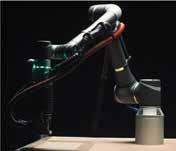



The Fimal Concept 350 PLUS Saw is a revolution in cutting, offering the advantages of a beam saw along with the versatility of a panel saw and taking up 50% less space than a traditional circular saw.
The Fimal P450AX Sliding Table Saw is a saw blade unit, with a long shaft, runs vertically along ground bars. The sliding system adopted on the new carriage, with large diameter bearings that roll along tempered and ground prismatic tracks, provides excellent smoothness and ± 0.05 mm straight cutting along the whole carriage stroke.
6 Axis robotic arm and controller, with 0.1 mm accuracy and process repeatability.
• No programming experience required
• Dual work Stations creates constant production
• Compatible with all varieties of cabinet doors
• Integrated Dust extraction system
• Unlimited amount of customizable sanding patterns
















278 Orenda Road, Brampton, ON L6T 4X6 - 800 386 5222
CASADEI E550 CRT
CASADEI E450
THE NEXT GENERATION OF
VISIT US AT IWF BOOTH #B7811
FIMAL P450AX SLIDING TABLE SAW
DOOR SANDING IS HERE FIMAL CONCEPT 350 PLUS

SIVAM Coatings Welcomes Luis Sousa and Jared Pemberton to North American Team
SIVAM Coatings announces the addition of Luis Sousa and Jared Pemberton to its North American team, marking a strategic move to enhance its market position. This addition aims to leverage their combined 50 years of experience in the wood coatings industry to support SIVAM’s growth and innovation efforts.
Luis Sousa, based in Ontario, Canada, brings 30 years of industry experience, specializing in wood coatings for designers, manufacturers, and finishers. His expertise in European manufacturing techniques will expand SIVAM’s finishing options for clients.
Jared Pemberton, from Utah, USA, has 20 years of experience in coatings, sales, and understanding market trends. His skills in networking and communication are expected to boost SIVAM’s sales and client relationships.
SIVAM Coatings aims to strengthen its competitive edge and customer satisfaction through these strategic hires, as it continues to innovate in the wood coatings market.



Palliser Names Steve Ambeau President in Strategic Organizational Shift
Palliser Furniture, a premier home furnishings manufacturer in Winnipeg, Canada, has appointed Steve Ambeau as the president of the Palliser brand. Ambeau will oversee key departments such as sales, studio development, product and merchandising, research and development, quality, IT, marketing, and customer care, reflecting a new organizational structure.
Since joining as group CMO for Palliser and its affiliate, EQ3, in June 2021, Ambeau has significantly influenced the brand’s evolution and positive organizational changes. CEO Peter Tielmann expressed confidence in Ambeau’s leadership, anticipating continued progress under his direction.
With over 25 years of experience in the U.S., Canada, and Europe, including significant roles at BMW Group, Ambeau brings extensive expertise in customer insights, performance marketing, digital strategies, and cultural transformation. He aims to integrate Palliser’s rich heritage with a forward-looking vision, ensuring the brand’s commitment to quality, craftsmanship, and customer satisfaction continues to thrive, promising a future that re -

spects tradition while embracing innovation.

Andy Turner named Bürkle North America CEO
Bürkle North America Inc. (BNA), a subsidiary of Robert Bürkle GmbH, has announced Andy Turner as its new CEO following a strategic realignment completed in March. This move is part of a broader initiative to strengthen Bürkle’s market presence in North America and enhance its global sales strategy, particularly in surface and lamination technology.
Andy Turner, with his previous experience at the WEINIG Group, is set to lead BNA in this new phase. His appointment is aimed at driving long-term growth and expanding Bürkle’s leadership in lamination and coating technology. Turner expressed confidence in the strategic realignment, stating, “I am convinced that this new direction will enable us to better meet the needs of our customers and strengthen our position as a preferred partner in the industry. Our aim is to offer not only high-quality products but also first-class service.”
This realignment includes intensifying the focus on direct machine sales and service expansion, aiming to respond more effectively to the North American market’s needs and ensure greater customer proximity through an expanded sales network.
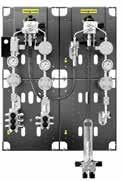
10 WOOD INDUSTRY SUMMER 2024
FILINGS
BEST CHOICE for PRODUCTIVITY and PEACE OF MIND Cyclomix® Evo the newest solution for mixing and dosing 2 & 3 components sames.com marketing.us@sames.com 800.573.5554 USA 800.450.0655 CAN HIGH PRODUCTIVITY PERFECT DOSING & MIXING OPTIMIZED WASTE MANAGEMENT
Available



Our K 945S panel saw offers modern design, innovative

operating elements, durable precision, extreme performance and maximum operating comfort. Felder’s 10 year guarantee ensures piece of mind and reliability for years to come.













The precisely milled, cast iron machine table with a 700 x 840 mm (27 x 33 in) extension on three sides offers more support for large dimensioned workpieces. With the easy to mount circle cutting and sanding units, the new Felder bandsaw is a versatile investment for perfection in woodworking.












The perfect addition to CNC supported production processes. With a solid cast iron moulding table for vibration-free stability or with the reliable ‘X-Roll’ sliding table for excellent slot and tenoning work – with spindle moulders from Felder you are prepared for every challenge a modern woodworker could face. FELDER SLIDING TABLE PANEL SAW
























The AD 941 planer thicknesser inspires and amazes woodworkers all over the world. Perfectly planed surfaces, maximum reliability and userfriendliness that is in a class of its own and top operating safety.











SETTING STANDARDS WITH OUR
FELDER BANDSAW FB 710 FELDER PLANERTHICKNESSER AD 941 FELDER TILTING SPINDLE MOULDER F 700
K 945 S
Much more than just a bandsaw
HIGHER
STANDARD MACHINERY
with the revolutionary PCS® safety device In a class of its own with 410 mm planing width Ready for every challenge
FELDER GROUP CANADA Machines + Tools for woodworking
FELDER GROUP MISSISSAUGA, ON 1-866-922-8879
FELDER GROUP CALGARY, AB 1-866-922-8879 info@felder-group.ca BURNABY, BC Ultimate Tools 1-604-291-WOOD(9663) felder@ultimatetools.ca FELDER GROUP MONTRÉAL, QC 1-514-673-9090 info@felder-group.ca WALLACE MACHINERY & TOOL CO. LTD. OAK BLUFF, MB 1-204-788-1199 kevin@wallacemachinery.com FELDER GROUP CANADA 1-866-922-8879 | www.felder-group.ca
info@felder-group.ca
IMPLEMENTING AUTOMATION A Strategic Overview in Woodworking
By Tyler Holt, Editor of Wood Industry Magazine
Industry 4.0 represents the frontier of manufacturing innovation, characterized by the integration of advanced automation, data exchange, and production technologies. This fourth industrial revolution encompasses cyber-physical systems, the Internet of Things (IoT), cloud computing, and cognitive computing, marking a significant transformation in how products are designed, fabricated, and distributed.
For the woodworking sector, the implications of Industry 4.0 are profound, offering opportunities to enhance efficiency, customize products more effectively, reduce waste, and sharpen competitive edges in a market increasingly driven by precision and speed.
The current landscape of the woodworking industry, largely comprised of small to medium-sized enterprises, faces considerable challenges such as labor shortages and rising material costs. These challenges underscore the critical need for adopting advanced manufacturing technologies. Automation and digitization stand out as essential strategies, not merely for optimizing production efficiency but also for meeting the growing demand for customized woodworking solutions. The integration of Industry 4.0 technologies enables woodworking firms to streamline operations and respond more agilely to market demands.
Industry reports and case studies reveal that while the adoption levels of such technologies vary, the trajectory is clear—firms are increasingly looking to leverage these innovations to stay viable in a competitive global marketplace. The implementation of automated solutions, as noted, does involve substantial investments and carries risks of significant losses if not managed properly. However, the potential to fundamentally enhance operational capabilities and open new avenues for innovation makes this a strategic imperative for the sector.
INDUSTRY 4.0 AND AUTOMATION IN WOODWORKING
Industry 4.0 marks the ongoing digitization and rapid technological advancement across various industries, representing the fourth industrial revolution. This era follows the introduction of steam-powered machinery in the 1780s, the assembly line in the early 20th century, and programmable logic controllers in the 1960s. Industry 4.0 in the manufacturing context signifies a transition to smart manufacturing systems that integrate data across operations, heralding a transformative approach to how products are designed, manufactured, and delivered.
Central to Industry 4.0 are key technologies such as additive manufacturing, augmented reality, cloud computing, cybersecurity, and big data analytics. These technologies enable the creation of smart factories that are adaptable, efficient, and capable of producing highly customized products. The vision of Industry 4.0 is a manufacturing landscape where intelligent machines, systems, and workpieces are interconnected through the Internet of Things (IoT), facilitating a seamless flow of information from the initial customer contact to the final product delivery. This interconnectedness ensures that every piece of the manufacturing puzzle is uniquely identifiable and operates in sync with the entire production chain, from control centers to individual processing machines.
In woodworking, the application of Industry 4.0 technologies can revolutionize traditional practices. CNC machines enhance precision in cutting and shaping wood, while robotic arms can automate and improve the safety of physically demanding tasks. IoT applications offer realtime monitoring and optimization of tool conditions and maintenance schedules, crucial for the high equipment reliability demanded in modern production environments. These advancements not only increase operational efficiency but also significantly reduce waste and improve the customization capacity of woodworking firms, enabling them to meet the evolving demands of consumers for personalized products.
The implementation of such technologies, however, requires a structured approach, integrating comprehensive planning, investment in new skills, and adaptation to technological advancements, all while navigating the financial and logistical constraints inherent in smaller firms. The journey toward Industry 4.0 for many woodworking firms involves balancing these challenges with the potential for improved productivity and competitive advantage.
CHALLENGES TO AUTOMATION IN WOODWORKING
Adopting automation technologies in the woodworking industry presents several significant challenges, particularly for small to medium-sized enterprises
12 WOOD INDUSTRY SUMMER 2024 FEATURE
(SMEs) which dominate the sector. Financial constraints are foremost among these hurdles. The substantial initial investments required for modern automation equipment can be prohibitive for smaller firms, straining their budgets and questioning the viability of such expenditures. The return on investment (ROI) can be attractive, but achieving the economic scale necessary to justify these investments remains a critical challenge for smaller operations.
Strategic planning poses another significant barrier. Many woodworking firms lack comprehensive digital transformation strategies, which hampers the systematic adoption of Industry 4.0 technologies. Without a clear strategic vision, firms struggle to integrate new technologies in a manner that is sustainable and scalable. This lack of preparedness can lead to missed opportunities and inefficiencies, ultimately impacting the firm’s competitive position in the industry.
Organizational resistance to change further complicates the transition to automated systems. This resistance can be entrenched, spanning from top management to operational levels, often rooted in a preference for traditional methods and a reluctance to adopt new processes that disrupt established practices. Moreover, the technical complexities involved in integrating advanced, digital systems with existing legacy systems pose substantial challenges, requiring sophisticated solutions to ensure compatibility and functionality.
DEVELOPING A STRATEGIC PLAN FOR AUTOMATION
Developing a strategic plan for automation in woodworking requires a systematic approach, ensuring that every phase from initial assessment to final implementation is carefully strategized to optimize the integration of Industry 4.0 technologies. This step-by-step guide is designed to assist woodworking firms in navigating the complexities associated with this transition.
Background Study: The first step in the strategic planning process involves a comprehensive assessment of the firm’s current capabilities and
technological readiness, along with a deep understanding of market demands and customer expectations. This phase is crucial for identifying the internal strengths and weaknesses of the company, as well as the external opportunities and threats (SWOT analysis) that could influence the automation process. Such an evaluation helps in pinpointing the areas where automation can deliver the most value and identifying potential obstacles that may need to be addressed.
Pre-Study: Following the initial assessment, a pre-study must be conducted to further explore the specific improvements that automation could bring. This phase includes technology scouting to identify the most suitable technologies, benchmarking against industry standards to ensure competitiveness, and conducting initial feasibility studies to assess the practicality of integrating new systems. Clear objectives and the scope of the automation projects must be defined during this stage to guide the subsequent phases of the planning process.
Design of Conceptual Manufacturing Systems: This process involves the use of simulations and digital twins to visualize and predict system behaviors under different scenarios. Creating these models is pivotal in understanding the integration challenges and operational dynamics of the proposed automation solutions. This stage allows designers to experiment with different configurations and optimize system layouts before any physical changes are made.
Evaluation of Conceptual Manufacturing Systems: Each conceptual model developed in the previous phase needs to be rigorously evaluated based on several criteria such as costeffectiveness, technical feasibility, scalability, and potential return on investment (ROI). Iterative feedback loops with stakeholders, including production managers, financial officers, and floor staff, are essential at this stage to refine the systems based on practical insights and strategic considerations.
Detailed Design of Chosen Manufacturing System: The final design phase involves
detailing out the chosen manufacturing system. This includes the precise specifications for hardware and software, detailed layout plans, and the steps necessary for integrating the new system with existing processes. Risk management and contingency planning are also critical components of this phase to prepare for and mitigate potential implementation challenges.
Throughout this process, it is vital to draw on a mix of qualitative and quantitative research methods, including case study analysis, expert interviews, and market research. The insights gained from project management and systems design literature further underpin the planning process, ensuring that the approach adheres to proven theoretical frameworks and best practices.
LOOKING FORWARD
The transition to automation within the woodworking industry, guided by the principles of Industry 4.0, presents both significant challenges and transformative opportunities. Firms face considerable hurdles, including financial constraints, strategic planning deficiencies, skills shortages, and cultural resistance to change. Strategic responses to these challenges involve comprehensive assessments of capabilities, precise planning and design of manufacturing systems, and robust evaluations to ensure technical and economic viability.
To remain competitive and innovative, woodworking firms must embrace a culture of continuous improvement and lifelong learning. The integration of advanced technologies such as IoT, AI, and robotics into everyday operations will require ongoing training and development of the workforce. As noted in industry analyses, the successful adoption of these technologies is not just about overcoming initial barriers but also about sustaining innovation through “a structured and inclusive process” that continuously adapts to new challenges and opportunities. The future of woodworking lies in its ability to adapt, innovate, and thrive in an increasingly digital landscape.
www.woodindustry.ca 13 FEATURE
BALANCING AESTHETIC QUALITY
With Production Practicality in Wood Coatings
By Jakub Stachurski, Sales Director for North America at Sivam Coatings S.p.A.
At the outset of my career, my focus was solely on selecting a coating cycle that excelled in terms of performance and aesthetics, without due consideration for the production aspect. While this approach may be suitable for artisanal furniture makers or millwork companies catering to high-end clientele where cost is not a significant factor, it does not align with the reality faced by most woodworking shops.

14 WOOD INDUSTRY SUMMER 2024 COLUMN
CHOOSING THE RIGHT FINISH CYCLE: MONO-COMPONENT VS. TWOCOMPONENT
For the majority, overly intricate coating processes can impede efficiency in terms of time and labor, consequently inflating costs. Employing products with excessive features, which may not substantially benefit the overall project, can introduce additional expenses that are challenging to recover from the customer. It’s crucial to strike a balance and avoid overcomplicating the process to ensure practicality and cost-effectiveness in production.
There are two primary categories of coatings available: Single-pack monocomponent systems or 2k systems. The crucial factor in choosing between them lies in catalyzation/crosslinking and the required accuracy in this process. Technologies like 2k Polyurethane or 2k Acrylics offer flexibility, allowing variations in the catalyzation rate without significantly impacting usability. Conversely, products such as conversion varnish can face serious issues like acid bloom with even slight deviations from the determined ratio. Adding a catalyst, crosslinker, hardener, or activator introduces the concept of pot-life, indicating how long a product remains usable after preparation. Water-based ISO Hardeners have a short pot-life of 1-2 hours, while 2k polyurethanes typically range from 3-5 hours, conversion varnish and 2k acrylic products can extend from 8-24 hours. Polyester, with the most challenging pot-life of 10-20 minutes before solidifying, requires careful consideration. Some products may involve inoculation time or require slow mixing of part B under constant agitation. Polyester, a three-component product, demands a specific order of mixing to avoid potential dangers.
1k Water-Based products offer a versatile solution as they can be used as such or crosslinked on the last coat with an ISO Hardener (though this introduces pot-life). Alternatively, a crosslinker like poly-aziridine can be employed to improve product crosslinking without pot-life consideration. Equipment solutions, such as plural component pumps or specialized spray guns


European Oak treated with a “White-Wash” water-based stain and coated with a low-gloss 2k Acrylic clear finish has been chosen to preserve its very light color and highlight the open grain texture as the primary focus of the finish cycle.
Credit: Lauten Woodworking
that mix at the tip of a gun, can simplify the use of 2k products but come with a significant cost investment.
With heightened performance comes increased complexity, as witnessed in certain products available in today’s
market boasting exceptionally highperformance attributes. Notably, the emergence of non-isocyanate crossovers as replacements for 2k Polyurethanes and 2k Acrylics stands out among these advanced options. While these products
www.woodindustry.ca 15 COLUMN
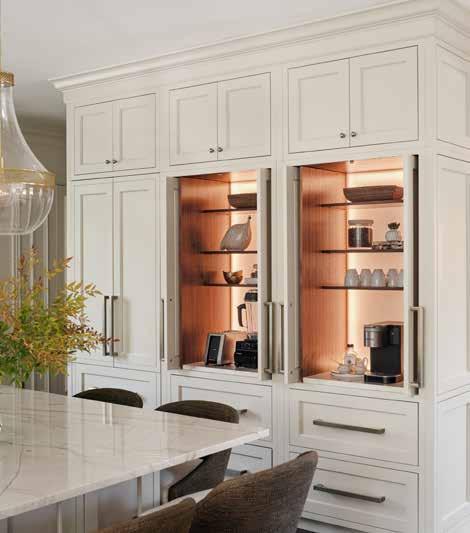
becomes particularly important when dealing with pigmented solid colors, fullfill, higher sheen finishes, and finishes applied over tight-grain wood/veneer species. Companies employing hanging lines for their application processes prioritize the product’s verticality. Conversely, smaller, and medium-sized shops typically use products suitable for both horizontal and vertical surfaces. Projects such as dining room and conference tables, large format panels along with high gloss applications, require a product that lays down easily. Adjustability, such as viscosity alteration with thinners and the choice of equipment, offer some control over this aspect. Temperature and humidity can also serve as influential variables. Certain products, notably water-based and exterior coatings, exhibit a higher threshold for vertical hang. Using an inappropriate product on vertical surfaces will require significant adjustments to the product and application, which can significantly impact a shop’s productivity.
DRYING AND CURING: OPTIMIZING SPEED AND QUALITY
offer notable advantages, it is crucial to acknowledge the associated costs beyond mere financial considerations. The intricacies lie in specific adherence procedures, stringent “catalyzation” rates, and precise application time frames, demanding a significant investment in time, labor, and education to effectively utilize such products. This heightened difficulty elevates the learning curve above the average, ultimately contributing to added costs. Engaging in unique or specialty finishes further amplifies the challenge, necessitating specific steps that should be carefully contemplated before undertaking the endeavor. Only a select few who have embraced and successfully navigated these chal-
lenges have gained a competitive edge over their peers.
It is essential to evaluate whether the performance of a two-component product is necessary for the desired outcome or if a mono-component product can simplify production without compromising quality. A targeted approach to production might be necessary and investments in training and proper equipment must be considered.
APPLICATION PROCESS: VERTICALITY AND ADAPTABILITY
A critical factor influencing the application process is the product’s ability to lay down smoothly on horizontal surfaces or maintain verticality. This aspect
One of the key considerations when evaluating products for end-user applications is the drying/curing speed, particularly in the context of larger-scale manufacturing where the stack and pack aspect plays a crucial role, influencing decisions such as when to flip the parts for spray application or expedite assembly and exit from the facility. Furthermore, there are specific scenarios where expediting the drying or curing process is essential, with high gloss serving as a prime example. It is imperative not to rush the initial flashing off to allow the product to settle as smoothly as possible. After the flash off time, a forced curing process can be implemented to accelerate solvent evaporation, induce film shrinkage, and prepare the product for the polishing stage. With the increasing trend towards automation in recent years, a different perspective is applied to the assessment of product chemistry. This focus extends to determining which forced curing technology aligns best with a specific product, as well as implementing appropriate
16 WOOD INDUSTRY SUMMER 2024
Cabinetry in the kitchen features 5-piece doors, coated with a solid-colored 2k Polyurethane chosen for its durability and capacity to withstand substrate movement. The interior walnut is treated with a 2k Acrylic low-build clear topcoat. Both products were selected for their outstanding resistance to moisture and chemicals.
COLUMN
Credit: ATS Design Studio
ENGAGING IN UNIQUE OR SPECIALTY FINISHES FURTHER AMPLIFIES
THE
CHALLENGE,
NECESSITATING SPECIFIC STEPS THAT SHOULD BE CAREFULLY CONTEMPLATED BEFORE UNDERTAKING THE ENDEAVOR.
flash off procedures before initiating the forced curing process. A plethora of technologies exist, including vertical ovens with laminar heat, convection ovens, drying tunnels, infrared (IR), catalytic heaters, ultraviolet (UV) systems, LED UV, Excimer, and more. The optimal curing technology used for water-based products versus solvent-based ones varies, leading to variations in results and productivity. This diversity adds complexity to the overall discussion, forming a vast subject of its own.
COATING CHARACTERISTICS: BUILD, COVERAGE, OPACITY AND SANDING
The build, coverage, opacity, and sanding properties inherent in coating products play a pivotal role in determining the quantity of product and the associated time required. This impact is particularly pronounced in the application of pigmented opaque finishes, where the goal is to achieve a solid, full coverage color on a flawlessly smooth surface. Primers are critical in this context, requiring the appropriate build to conceal imperfections in the substrate. The build facilitates the application of fewer coats, streamlining the filling process, and subsequently allowing for a simplified sanding process. The pigmented topcoat, on the other hand, should exhibit excellent coverage to achieve the desired and consistent color in one or two coats. Italian 2k Polyurethane, 2k Acrylic, and waterbased systems, each equipped with their proprietary pigment systems, tend to excel in meeting these criteria. Among them, 2k Polyurethanes stand out due to their high solid content.
Enamel holdout and primer porosity are critical yet often overlooked factors. They refer to the basecoat’s ability to create a layer that allows the topcoat to settle

www.woodindustry.ca 17
COLUMN
Natural American oak, clear-coated with a low-sheen, low-build 2k clear acrylic for both durability and the preservation of the wood’s beauty and texture. Credit: Lauten Woodworking

properly, minimizing absorption and facilitating the creation of a uniform sheen during the application of the final coat. This aspect becomes particularly emphasized in the application of low-sheen and specialty products, such as anti-scratch pigmented topcoats, where achieving a homogeneous sheen is crucial.
The adhesion of a finish to the substrate can be influenced by several factors during the application process. Over-sanding with a grit that is too high or using worn-out sandpaper can result in a polished wood surface, affecting adhesion. Considering the hygroscopic nature of wood, the etched pattern formed during sanding can absorb moisture over time, potentially causing swelling and further adhesion challenges. Another common issue is using an incompatible stain type, such as domestic solvent-based wiping stains with 2k Polyurethanes, 2k Acrylics, or water-based products, leading to potential problems. Factors like using an over-tinted stain with excessive pigment, leaving a residue, or sealing an under-
cured stain hastily can also impact the outcome. Adhesion problems often arise from a combination of these factors. For instance, sanding a high-density wood such as hickory with 180 grit, applying a heavily pigmented solvent-based wiping stain a week later, and top-coating it with 2k Polyurethane an hour afterward will result in failure.
Inter-coat adhesion is crucial. Some products, such as Nitrocellulose and precatalyzed lacquers, exhibit both chemical and mechanical adhesion, simplifying the layering process. Conversion Varnish, 2k Polyurethanes, 2k Acrylics, and water-based products all rely on mechanical adhesion and require a proper scratch pattern for subsequent coats. It is important to note that coatings similar to wood substrates are hygroscopic, absorbing moisture and affecting the scuff-sanded pattern, emphasizing the importance of conducting scuff sanding on the same day as overcoating. 2k Polyurethanes, 2k Acrylics, and waterbased products have the added benefit of
chemical adhesion, allowing for wet-onwet application to save time and labour, provided the recommended time frame is observed.
Generally, adhesion is more influenced by the application process than the specific product used, but the formulation of the product has an impact as well. Products have varying viscosities, products with lower viscosities exhibit better wetting properties/ capillary action, (penetration of microscopic channels and irregularities in the substrate) and enhance mechanical interlocking. Curing and crosslinking processes of certain products strengthen the molecular structure and promote adhesion.
High-density woods or those rich in natural oils, such as teak, may pose additional challenges, especially with water-based cycles. Factors like wood pH balance, extractive substances such as tannin, and resin content play roles in these challenges. To address them, isolating basecoats are available to create
18 WOOD INDUSTRY SUMMER 2024
COLUMN
A walnut bookshelf, stained to complement patina bronze accents, is coated with a low-sheen, low-build clear finish. Credit: Lauten Woodworking
a barrier, and ensuring the proper adhesion of the entire coating cycle.
HEALTH AND ENVIRONMENTAL CONSIDERATIONS
Prioritizing environmental impact and personal health while achieving outstanding results has become increasingly crucial. The focus on Volatile Organic Compounds (VOCs) is particularly prominent in the current discourse within the industry. These compounds are released into the atmosphere during the atomization process of the products we spray, and consideration of their impact can stem from an individual’s environmental conscientiousness or adherence to local regulations.
In large-scale manufacturing scenarios where a specific quantity of allowable VOC release is permitted, Water-Based (WB) products emerge as leaders, featuring significantly lower VOC content compared to their solvent-based counterparts. The chemical composition of certain applied products can introduce elements such as formaldehyde and isocyanates. Apart from specialized formaldehyde-free formulations, pre-catalyzed lacquers and conversion varnishes typically contain formaldehyde, released both during application and gradually from the cured film over months. In contrast, 2k Polyurethanes and 2k Acrylics utilize bonded isocyanate resin as part B with modern formulations ensuring that isocyanate is present only during the atomization process and dissipates once flashed off. It’s crucial to highlight that even 2k Water-Based products incorporate isocyanate in their hardeners, although emerging technologies are offering non-isocyanate hardeners or use of non-toxic aziridine crosslinkers.
The potential health risks associated with exposure to formaldehyde, a known carcinogen, and isocyanate, which can cause respiratory issues, underscore the importance of mindful product selection. Companies are increasingly motivated to adopt water-based products, aligning with market preferences for environmentally friendly solutions and enhancing their ‘green’ image.
In the end, the choices for which products to use and for what reasons are
virtually limitless, offering endless options. It is crucial to prioritize not only the cost of the product but also its application. Striking a careful balance between the necessary performance and aesthetic features for the project and the associated costs is
key. Avoiding unnecessary complexity while understanding what features can facilitate a streamlined production. Achieving this balance ensures that the selected product is not only cost-effective but also well-suited for its intended application.
Based in Vancouver, Jakub Stachurski is the Sales Director for North America at Sivam Coatings S.p.A. With 20+ years in the industry, he specializes in European coating systems, often advising at UBC’s Centre for Advanced Wood Processing, blending heritage with innovation.
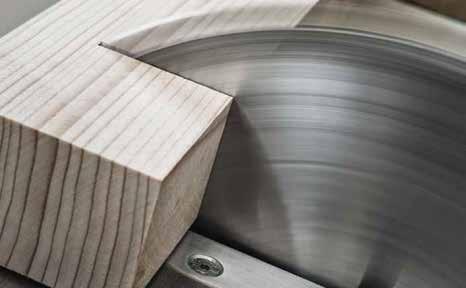

FAST500 MATRIX
HIGH-SPEED CROSSCUTTING SAW

Versatile crosscutting cut-off saw delivering exceptional performance at extremely high speeds.
The Stromab FAST500 MATRIX is a straight cut-off saw with an innovative electronic push feed system and controlled axis. It has been constructed to be highly efficient and increase production with up to 40% more production over the standard model. This state-of-the-art machine blends the reliability of a pneumatic cut-off saw with an ascending saw blade with an electronic push-feed system pusher system which is driven by a precision and high-speed rack and pinion guide system.

www.woodindustry.ca 19
www.akhurst.com Delta, BC | Edmonton, AB | Mississauga, ON | Montreal, QC | Dieppe, NB
Building Trust. Creating Together.
COLUMN

PLANNING TO AVOID THE MOST COMMON AUTOMATION PITFALLS
By Yohaan Thommy, Partner at MNP
Automation is frequently touted as the solution for the manufacturing industry’s labor shortages and other challenges. While automation does hold immense potential, its implementation requires careful consideration and planning to avoid costly mistakes. A poorly executed automation strategy can lead to bottlenecks, reduced productivity, and increased costs, all of which undermine the intended benefits. For the average Canadian Woodworking company that has 10 or less employees, a misstep can take years to recover from, or even be fatal to the company’s financial viability and sustainability. Learning from our client’s successes and discoveries we wanted to share some best practices about how to approach, implement, and think about automation.
20 WOOD INDUSTRY SUMMER 2024
FEATURE
A first step for businesses should be deciding why they want to automate and what are the objectives. This can be thought of as the ‘North Star’ in the automation journey, one that helps to frame the conversation and provides a good foundational brief for any request for information (RFI) or request for proposal (RFP). This ensures that your executive team, ownership, potential suppliers and the automation vendor are all on the same page on what the desired outcomes are. So often, we see clients purchase an expensive “nice to have” or “state of the art” technology that they don’t need and simply adds more to their cost structure in an already competitive industry.
One of the critical factors in deciding whether to automate is calculating the return on investment (ROI). Many companies use a formula that typically aims for a two-to-three-year ROI period to assess the financial feasibility of automation projects. While the target ROI pe -
riod can vary depending on the nature of the work and the company’s specific goals, using it as a guideline can prevent companies from investing in projects that are not financially viable. ROI is even more important as interest rates are higher. Remember that you should also plan for disruptions to our ROI and use a conservative ROI by planning for potential delays to the project or added costs which in most projects are inevitable. Typical added costs are bear load testing, soil testing, permits, transportation costs, changes to the facility, needing to upgraded your compressed air, electrical, training, financing costs and added maintenance costs
As part of the ROI calculation, businesses should evaluate the level and complexity of automation needed to satisfy the requirement. Its poignant to remember that implementing automation doesn’t stop at the equipment purchase and installation. There are servicing, maintenance and labour needs
The Clean Air Company

required to sustain automation through its intended life cycle.
We know automation has the capacity to bring significant benefits to various areas within a manufacturing operation. Here’s where companies could yield benefits:
Improving Health and Safety: Automating
dangerous or physically demanding tasks can significantly enhance the health and safety of workers. By removing workers from hazardous environments, automation reduces the risk of workplace injuries and illnesses.
Reducing Repetitive, Low-Value Work:
Automation is particularly effective at handling monotonous, repetitive tasks that offer little value beyond completion. By automating these tasks, companies can free up their workforce to focus on more complex and high-value activities that require human creativity and problem-solving skills.


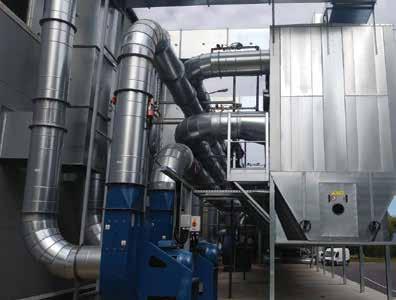
www.woodindustry.ca 21
FEATURE
Booth B4547 Experience Clean Air Optimized
Reduce energy consumption by up to 70% through intelligent airflow control Scan to learn more! Quiet, turn-key enclosure-less dust collectors Modular baghouse central dust collectors with smart filter technology
Nederman SAVE
Material Handling: Automating material handling tasks can have a substantial impact on efficiency and productivity. Automated systems can handle the movement and storage of materials with greater speed and precision than manual labor, reducing the risk of errors and delays in the production process. Quality Control: Automation can also improve the quality control process by reducing human error and ensuring
consistency in product quality. Automated systems can perform precise measurements and inspections, leading to fewer defects and higher customer satisfaction.
Inventory Management: Automating inventory management can help companies optimize their inventory levels, reduce carrying costs, and minimize stockouts. Automated
CANADIAN MARKET
WEEKLY E-DIGEST
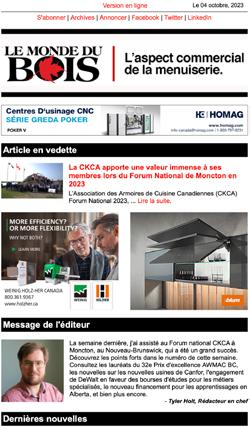




www.woodindustry.ca www.lemondedubois.com
systems can track inventory in realtime, enabling companies to make data-driven decisions about inventory replenishment and storage.
Mitigating Labour shortages: Automation offers a potential solution to labour shortages. Finding and retaining labour presents a challenge in todays market, not just with skilled labour but also with work requiring monotonous, repetitive tasks. Machines don’t bore!
Despite the potential benefits of automation, companies must approach automation with caution and careful planning. The key considerations to ensure automation solutions deliver the intended results are as follows:
Start Small & Ensure you use data to analyze your plant’s contraints: It’s often best to start with smallscale automation projects to gain experience and identify potential challenges before scaling up. Automate your constraint (read more about the theory of constraints). We recently helped a company identify that by fixing one process they could double their plant’s output because this work center was running half as slow a the entire plant. Therefore, they needed to just automate or improve productivity in this one center and it would give them more capacity than they could sell. They did not need to buy additional equipment for other work centers until they could double their sales. The company saved several hundred thousand dollars, not to mention the added effort and risk involved in changing processes.
Involve Employees: Employees are a valuable source of insights and feedback. Involving them in the automation process can help ensure that automation meets their needs and addresses their concerns. If this is not done correctly, there will be resistance and push back as the employees see this as the company’s plan to replace them all with robots, which in most cases, is not the case.
22 WOOD INDUSTRY SUMMER 2024
SUBSCRIBE for Free KEEP YOUR FINGER ON THE PULSE OF THE
WITH Canadian industry news, feature articles, product profiles, design and technology updates delivered to your inbox every week.
FEATURE
Focus on Training: Automation often requires employees to learn new skills or adapt to new ways of working. Providing adequate training and support is essential to ensuring a smooth transition to automation.
Evaluate the Technical Expertise Needed for Maintenance and Troubleshooting: Despite its goal of simplifying work processes, automation often demands highly skilled and trained technicians to maintain and troubleshoot the system effectively. Proper planning to ensure the availability of qualified resources is crucial. Overlooking this step could have huge productivity and/ or cost implications.
Avoid over Automation: Acquiring overly complex pieces of equipment with high maintenance needs can mandate costly critical spare parts, scheduled maintenance, and upgrades. Thoroughly understanding your automation needs and executing detailed vendor selection processes can mitigate the possibility of purchasing overly complex solutions with a high financial burden when more manageable options are available. Your ROI and expected life span should factor this in.
Monitor and Evaluate: Continuous monitoring and evaluation of automation projects are crucial to identify any issues early and make necessary adjustments.
Finally, one further factor to consider when executing your automation strategy is how can you leverage automation to provide, enhance and lead your data ecosystem. With the maturity of Industry 3.0 practices and industry’s transition to Industry 4.0 and beyond, the Industrial Internet of Things (IIoT) presents significant opportunity for businesses to acquire and leverage data in their operations to manage production, inform decision making and monitor performance.
In conclusion, automation doesn’t need to be scary, it needs to be managed with care, attention and due diligence. While automation can offer sizeable
benefits to your manufacturing operations, it is not a one-size-fits-all solution. Companies must carefully assess their needs and objectives before embarking
on an automation journey. By approaching automation with caution and careful planning, companies can maximize its benefits and avoid potential pitfalls.
Yohaan Thommy is a Partner at MNP with over 15 years of consulting experience, primarily assisting privately held businesses in various industries, including woodworking, manufacturing, and services. He specializes in financial improvement, revenue growth, merger integration, and business turnarounds. Yohaan holds certifications as a Project Management Professional and Lean Six Sigma Black Belt and is deeply involved in community development.


FEATURE Booth B5535 Visit us! See The GANTRYX in Action! doucetinc.com / en 866 673-8876 info@doucetinc.com
WHY ARE “JOB RELATIONS”
Important to the growth of your business?
By Ric Ptak, Owner of ProductivityPros
Spoiler alert — if you are not the type of person that looks at your company and plans for future growth through strategic planning or looks to weather the storm of uncertainty ahead in the woodworking/construction industry, then, this article is NOT for you.
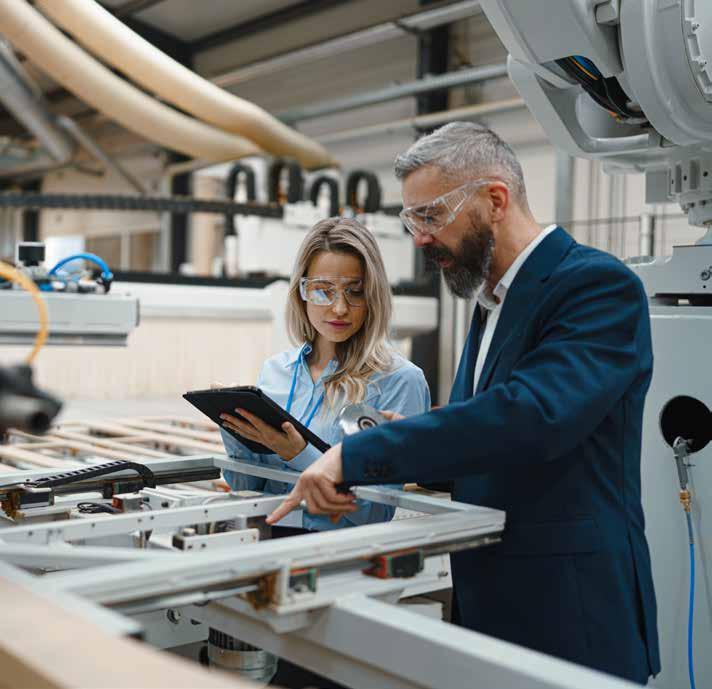
24 WOOD INDUSTRY SUMMER 2024 COLUMN
For those of you who are looking for the edge or looking for tools that can help your team move the needle for improvement and better quality projects which run smoother with less stress and perhaps better margins, then, yes, you’ve come to the right pit stop.
Job Relations is one of the essential skills required by your team to effectively run and maintain a successful woodworking/construction company. Did you know that the skill in job relations is one of the 5 needs required by supervisors (leaders) to thrive and contribute to the growth and success of the company and their employees? (The other 4 are: knowledge of work, knowledge of responsibilities, skill in instruction, and skill in improving methods).
We know that many supervisors in the trades became supervisors because they were great technicians — proficient in demonstrating the skills of their trade. They probably had exceptional teachers and role models and were passionate themselves about performing at a high level. Then, at some point they were asked to become a lead hand, foreperson, or supervisor. What did trade school teach about job relations, communication skills or handling people problems? My guess is little to nothing. Let’s discover how we could remedy this.
Job relations basically is the skill in being a leader. Supervisors get results through people and people need to be treated as individuals. Your greatest resource are your people. To be a respected leader that gets results through people, each of your leaders need to possess some of the following traits (or the willingness to improve those traits). Communicating clearly, empathy, prob-
lem solving, decision making, adaptability, empowerment, integrity, constructive feedback both giving and receiving are a few. Communication is the ability to convey or share ideas and feelings effectively. Leaders require great communication skills- both verbal and written. Part of communication skills (and perhaps the most important) is listening (active, being engaged) especially listening to understand and not listening to respond. Sprinkled into communication is your tone and body language, how you role model, what behaviors you use when providing that role model function, , I like (and coach) the TWI (Training Within Industry) approach for Job Relations. To build this leadership skill there are foundations for good relations which begin with the employees that you are leading. The 4 main ones are:
1. Let each worker know how they are doing. Figure out what you expect of the person and point out ways to improve.
2. Give credit when it is due. Express appreciation. Look for extra or unusual improvement and tell the person while it is “fresh” (as close to the present as reasonably possible)
3. Tell people in advance about changes that will affect them. Tell them why if possible, and work with them to accept the change.
4. Make best use of each person’s ability. Look for abilities not now being used and never stand in a person’s way.
Yes, I agree there is a lot of the so-called soft skills involved in the above founda-
tions for good relations. It is best not to downplay the need to assess these and identify any that require improvement. Remember also that Job relations extend beyond supervisor to the employees, that relationship is also in the opposite direction — employees to the supervisor. Then you have relations with fellow supervisors’, upper managers, owners, project managers, administration staff, engineering. Don’t forget the relations with outside vendors, general contractors, design professionals, installers, clients, insurance providers, health, and safety professionals just to name a few. Remember that the relationship amongst the above always goes both ways. Communicating within all these relationships needs to be done using respect as the default. A no blame culture works best, and when issues do arise the focus is on the process not the person. Attack the problem not the person.
I agree with the person who said that managers manage things such as schedules, materials, projects, equipment, buildings, safety, quality, costs, however, you don’t manage people, you coach/ mentor/lead people through relations. That is the essence of leadership. It can help the supervisor get the necessary cooperation from the other people so the project work can be carried out effectively. This depends on the output of the people involved and so the cooperation of the team is crucial. Using this skill in leading will help obtain cooperation and if used daily will ensure fewer problems arise. And even if problems come up using effective leadership skills within the Job Relations framework the supervisor can solve them.
A leader needs to understand how
SUPERVISORS GET RESULTS THROUGH PEOPLE AND PEOPLE NEED TO BE TREATED AS INDIVIDUALS. YOUR GREATEST RESOURCE ARE YOUR PEOPLE.
www.woodindustry.ca 25
COLUMN
to use the foundations for good relations and use them as a preventative step in building the rapport and trust of those folks they lead. You want to make people feel important and show interest in things that are important to them. Supervisors also need good sense and judgement along the way. People are individuals. Why? Because they are different. They have different backgrounds, cultures, health, personal/family situations, financial situations, religions/beliefs, hobbies… Folks don’t leave part of themselves at home when they arrive at work, they bring these differences along. These are differences that the leader cannot change however must understand they exist.
Sometimes problems arise due to those differences. A problem is anything the supervisor must act on. (If you leave it unsolved it may have a bad influence). So how do you handle a problem using the Job Relations approach under TWI method?
a. First you need to determine the objective. This takes some reflection before taking any action. What do you as the supervisor want the outcome to be after you take action, what is the desired result?
b. Once you determine the objective then you need to get the facts and be sure you have the whole story. Getting opinions and feelings is an important step here as well. Encourage the individuals concerned to talk about
what is important to them, and don’t jump to conclusions.
c. Next weigh and decide by fitting the facts together, brainstorm possible actions, make sure they fit with current policies, and consider the effect on the individual, group, and production. Your possible action should align with your objective, if not perhaps this is not the best action to take.
d. Now comes the take action part and check results by following up and checking output, attitudes/ behaviours, and relationships. Did your action help production? Did you accomplish your objective?
Remember to approach the situation with sensitivity and respect, maintaining open communication throughout the process. By addressing the issue collaboratively, clearly spelling out expectations, you can work towards a solution that meets both the worker’s needs and the requirements of the workplace.
One small tip about getting opinions and feelings — remember what a person thinks or feels whether right
or wrong is a fact to that person and should be treated a such. It is their perspective and by allowing them to express opinions and feelings might uncover some additional facts that may lead to different actions being taken, ones that have a better fit with the objective.
Do you want to grow your leadership team and give them the opportunity to acquire new skills or improve and hone existing ones? Just like keeping your tools sharp and equipment functioning through properly scheduled maintenance so to can you keep your team running optimally by making sure they are getting the necessary upgrading/training. Consider looking into a soft skills assessment to help identify blind spots or TWI Job Relations. It can help build confidence in your leadership team because they have additional tools at their disposal to use when dealing with issues. It also can help with accountability and stress reduction.
You now have some newfound knowledge and it’s up to you to act on that knowledge. Are you scheduling training/coaching into your core business strategy, so your folks have the extra tools to be successful?
With 40 years in manufacturing, Ric Ptak has journeyed from cabinetmaker to Industry leader, enhancing company efficiency and safety standards. An active AWMAC member and DCOE certified Master Black Belt Trainer, he’s improved numerous manufacturers’ operations. Based in Halifax, Ric offers services across Canada to optimize manufacturing processes, safety, and leadership, leveraging his extensive experience in operational excellence and employee engagement.
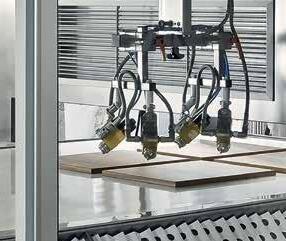


26 WOOD INDUSTRY SUMMER 2024
COLUMN
LOOKING FOR CUTTING-EDGE FINISHING TECHNOLOGY? Find your custom-made solution. venjakob-na.com IWF Atlanta | Aug. 06-09, 2024 | STILES booth #B4835/4853







The design to manufacture software solution for cabinet and closet professionals. KCD Software provides cabinet and closet professionals with a full suite of powerful and intuitive design tools that make it easy to create the ideal solution for virtually any space. Design Show your clients photo-realistic, 3D renderings of the finished design for their sign-off, generate real-time quotes and contracts to close the sale quickly. Sell Export your finished project to your choice of nested CNC Machinery or export precision cut lists for efficient traditional manufacturing. Manufacture DESIGNER PROFESSIONAL WORKSHOP CNC COMMANDER Let’s discuss the ideal solution for you. Call 508.760.1140 or Visit KCDSoftware.com KITCHENS | CLOSETS | GARAGE STORAGE | HOME OFFICES | ENTERTAINMENT CENTERS | MORE
VISIT US BOOTH #C2040
Kitchen shown was designed, machined & built by The Webhannet Co. using KCD Software
CUTTING COSTS AND THE CUTTING EDGE
 By Tyler Holt, Editor of Wood Industry Magazine
By Tyler Holt, Editor of Wood Industry Magazine
28 WOOD INDUSTRY SUMMER 2024
Scaling Automation with Luke Elias of Muskoka Cabinet Company

www.woodindustry.ca 29 FEATURE Credit:
Cabinet Company.
Muskoka

When Luke Elias took over Muskoka Cabinet Company in 1989, the concept of automation in woodworking was still nascent, especially for smaller, more traditional workshops. Elias, however, foresaw the potential of automation to revolutionize production processes. His initial steps towards automation were modest, driven by the need to streamline internal communication within the company, which was then heavily reliant on paper-based systems. By focusing on building an internal computer network, Elias set the stage for a more radical transformation.
The real shift began in the early ‘90s when Muskoka started to introduce specific pieces of automated equipment. This period marked the introduction of point-to-point machines, CNC routers, and horizontal boring machines—equipment that was crucial in increasing the precision and speed of production but was still in its relative infancy in terms of
broader industry adoption. The pivotal moment came towards the end of the decade, around 1999, when Elias was introduced to nested based manufacturing.
“Back then we had machines that did the toe kick cut outs and then a different machine that did the grooving and a different machine that did the horizontal. There was a lot of material handling go-
ing on between these machines. So nested based manufacturing was one single machine that did all those operations. We were the first one to get a nesting machine in Canada or in North America from Biesse and that’s kind of where it really started to take off.”
Adopting nested based manufacturing was not without its challenges. As
30 WOOD INDUSTRY SUMMER 2024
FEATURE
Muskoka Cabinet Company is touted as having one of the smartest manufacturing system in the Industry.
early adopters, Muskoka faced significant hurdles, particularly related to tooling and machine calibration. The initial tools available were not capable of meeting the demands of high-speed operation without causing damage to materials. This led Elias to seek solutions in unconventional places, such as online forums. It was through interactions on platforms like Woodweb that Elias connected with other industry professionals who could offer practical advice and share their experiences. This community-driven problem-solving was instrumental in overcoming the early technical challenges.
“This is what we go through as early adapters: everything looks good on paper, but when you actually go to use it in a production process is when all the flaws come out. Even the manufacturers might not have all the answers.”
Despite initial setbacks, these advancements not only improved the operational efficiency of Muskoka but also set a benchmark in the industry for what could be achieved with the adoption of automation. The journey of automation, led by Luke Elias, transformed Muskoka from a traditional cabinet maker into a leader in technological integration within the woodworking industry, showcasing the significant benefits of embracing technological change.
APPROACHING AUTOMATION
Luke Elias’s approach to automation at Muskoka Cabinet Company was far from impulsive; it was meticulously planned and rooted in a comprehensive understanding of data and workflow. The initial step in Muskoka’s automation strategy was always to collect and analyze data extensively. This data-driven approach allowed the company to understand its current performance levels across various metrics, setting a baseline from which improvements could be measured. The insights gained from this data were crucial in determining the specific needs for automation equipment and ensuring that any investment made would yield a tangible return on investment.
“The first step starts with data collection and analyzing the data. We need to


www.woodindustry.ca 31 FEATURE
Above: An automated sanding station. Below: An automated cabinet assembly cell.

know for sure what our baseline is and what our goal is, and we calculate the payback. Because when we invest, we usually go above and beyond all the data. We spend all the time we can collecting and analyzing data because optimizing production costs us a lot of money. With most purchases we make, we end up spending much more because we look for complete integration and question what is happening just before and after a machine.”
The analysis is not just about understanding how machines could speed up production but also about identifying areas where time and labour are wasted, thus freeing up resources for other value-adding activities. For instance, understanding the flow of materials through the shop floor helped Muskoka pinpoint where bottlenecks or redundancies occurred and which processes were candidates for automation or deletion. This could mean automating a single high-labor process or rethinking a series of tasks and the location of machines to create a more streamlined workflow.
VALUE STREAM MAPPING
Muskoka Cabinet Company’s utilization of Value Stream Mapping (VSM) represents a cornerstone of their approach to continuous improvement and operational efficiency. VSM is a lean-management method for analyzing the current state and designing a future state for the series of events that take a product or service from its beginning through to the customer. At Muskoka, VSM was not just a tool to identify waste but also a strategic element for enhancing the entire production process.
The initial implementation of VSM at Muskoka involved assembling a cross-functional team from various departments to map out every step in the production process. This exercise was crucial in highlighting redundant steps, delays, and bottlenecks that were previously unnoticed because they had become so embedded in the day-to-day operations. For instance, during one of their first VSM sessions, it was discovered that a significant amount of time was being wasted in the movement of
materials from one end of the shop floor to the other. In response, Muskoka reconfigured the layout of their equipment to minimize unnecessary handling and transport, resulting in a more streamlined workflow and reduced labor costs.
Today, Muskoka has several full-time employees in its continuous improvement department called SMARTWorks. This dedicated team is responsible for planning, engineering, developing, programming and implementing many of the production system’s the company uses like MES, RFID, AMR’s and robotics. Elias believes that success in the woodworking industry will be dependent on embracing technology and upskilling employees to use this technology. Leading to significant gains in productivity and thus better paying, more attractive careers.
For smaller shops wanting to implement VSM, the process does not need to be overly complex or resource-intensive. Small business owners can start by gathering a team of employees who are involved in the daily operations and conduct a simple walk-through of their
32 WOOD INDUSTRY SUMMER 2024
FEATURE
Photo Credit: Muskoka Cabinet Company.
SMALL SHOPS SHOULD FOCUS ON INCREMENTAL IMPROVEMENTS RATHER THAN COMPLETE OVERHAULS, WHICH CAN BE COSTLY AND DISRUPTIVE. THE AIM SHOULD BE TO MAKE SMALL, MANAGEABLE CHANGES...
processes. The key is to document every step, no matter how minor it appears, and then review these steps critically to identify any potential improvements. Even without sophisticated software or consultants, small shops can gain valuable insights by using basic tools like whiteboards or flowcharts to visualize their processes.
Additionally, small shops should focus on incremental improvements rather than complete overhauls, which can be costly and disruptive. The aim should be to make small, manageable changes that can have an immediate impact on efficiency. Regular VSM sessions can help maintain momentum and ensure continuous improvement, adapting the process as the business grows and changes.
MEASURING AND MANAGING WITH AN MES
At Muskoka Cabinet Company, the
implementation of a Manufacturing Execution System (MES) was a strategic move to further enhance operational efficiencies and ensure the accuracy of production data. MES systems serve as a crucial bridge between the planning layer of a business, typically handled by Enterprise Resource Planning (ERP) systems, and the actual physical processes occurring on the shop floor. For Muskoka, the MES was pivotal in providing realtime data that could be used to monitor production processes, track progress against production goals, and identify areas needing improvement.
The MES at Muskoka facilitated a much more dynamic approach to managing production. It allowed for real-time tracking of each component and assembly through the shop floor, providing immediate feedback on the status of various jobs. This capability was
instrumental in reducing downtime and bottlenecks, as issues could be identified and addressed much more swiftly than before. Furthermore, the system improved communication across the factory floor by providing a common platform through which all relevant personnel could access up-to-date information about production activities.
“MES is a subset of ERP but really, production tracking has to do with the process and the execution on the shop floor- how, for instance, the parts travel around and tracking them. You can’t set it and forget it. If you put in a system like this, you are going to be continually updating it. But it’s like so many other things — the value that you’re going to get far outweighs the time that it’s going to take to keep this system implemented and up to date. If you were to take

www.woodindustry.ca 33
FEATURE
An automated guided vehicle trucks components around, replacing the back-and-forth previously done by employees.

the leap and hire a person to implement and maintain the system, that would pay for itself in spades, especially if you want to grow.”
For smaller shops looking to adopt similar technology, the advice from Muskoka’s experience is clear: start small but think strategically. Even a basic MES can provide significant benefits in terms of improved data accuracy and operational visibility. Small shops should begin by identifying their most critical information needs—such as job tracking, machine utilization, or inventory levels—and implement a system that addresses these areas effectively. The key is to choose an MES that is scalable and can grow with the business.
Small shop owners should consider the potential for reduced waste, improved production times, and enhanced ability to respond to problems as compelling reasons for the investment. It’s also important for small shops to ensure that the MES they choose can integrate seamlessly with any existing systems, such as design software or customer management systems.
Implementing an MES system also requires a cultural shift within the company. Shop floor employees need to be trained not just on how to use the system, but also on how it can make their jobs easier and more productive. Adoption by all users is critical to realizing the full benefits of the MES.
TRADE ASSOCIATIONS AND THE ONE THING
Muskoka Cabinet Company’s active involvement in trade associations, particularly the Canadian Kitchen Cabinet Association (CKCA), has played a pivotal role in its development and continuous improvement strategies. Elias has emphasized the value derived from participation in these industry groups, which serve as platforms for networking, knowledge sharing, and collective problem-solving among peers.
“I always I call it ‘the one thing.’ And it started many years ago. We attend a lot of the trade shows, and if I learn one thing that will change something
in my business it’s worth it. We are one of the only industries that doesn’t mind sharing. In May the CKCA is hosting an event with multiple shop tours and we’re going to have Miralis touring Cabico’s factory. Well, you’re never going to see Ford touring GM’s factory, right? Yet we open our doors to each other. The value of the CKCA is tremendous for that one fact alone. We’ve been members of the CKCA for a long time but I didn’t participate as much because I was thinking ‘what am I even going to see?’ But I changed my attitude because I’ll go into a small shop or a big shop or any shop and I’ll see that one thing that I would see going to an event like IWF. Whether it’s dealing with employees or vendors there’s a vast array of activities that go on in a business and you always learn something. So, I go to all of them now and I love them. I really love them. I promote them highly.”
The value of trade associations extends beyond just the acquisition of new knowledge. They also offer opportunities for businesses to influence industry standards and policies, which can have far-reaching effects on market conditions and operational environments. For smaller shops, the benefits of association membership are even more pronounced. These businesses often operate with limited budgets for research and development, and gaining access to a concentrated pool of industry knowledge and experience through association activities can be transformative.
Luke Elias’s experience at Muskoka Cabinet Company exemplifies the profound benefits of embracing automation and strategic planning in wood manufacturing. By implementing data-driven approaches like MES and Value Stream Mapping, Muskoka has significantly boosted efficiency and productivity. Additionally, Elias’s active participation in trade associations highlights the importance of industry engagement for gaining insights and driving innovation. Manufacturers of all sizes are encouraged to explore how automation can enhance their operations and to consider the benefits of joining trade associations to stay competitive and informed.
34 WOOD INDUSTRY SUMMER 2024
FEATURE





















































































The new Felder edgebanders G363 and G383 with robust chain conveyors and application-controlled premilling unit in the standard version impress with their performance, flexibility and ease of use at the best price-performance ratio.
With the usual high level of Felder operating convenience, it takes just a few simple steps to adjust the machine to different materials or edge thicknesses between 0.4-5
























































































FEATURE PERFORMANCE, FLEXIBILITY AND USER COMFORT ALL IN ONE!
Touchscreen control for maximum operating comfort Compact design, reliable, high-quality mechanical engineering - perfect machining results. Up to 3 finishing units for the cleanest results Corner Rounding Unit FELDER GROUP CANADA Machines + Tools for woodworking FELDER GROUP MISSISSAUGA, ON 1-866-922-8879 info@felder-group.ca FELDER GROUP CALGARY, AB 1-866-922-8879 info@felder-group.ca BURNABY, BC Ultimate Tools 1-604-291-WOOD(9663) felder@ultimatetools.ca FELDER GROUP MONTRÉAL, QC 1-514-673-9090 info@felder-group.ca WALLACE MACHINERY & TOOL CO. LTD. OAK BLUFF, MB 1-204-788-1199 kevin@wallacemachinery.com FELDER GROUP CANADA 1-866-922-8879 | www.felder-group.ca G363 & G383 EDGEBANDERS mm. Start processing units, regulate
temperature and receive feedback on
current
7” touch screen. The new models can be
your needs thanks to
interchangeable
cleaning and release agents.
glue
the
machine status via the
individually configured to meet
the Felder modular system - from the Teflon-coated
glue pot to spraying units for
THE HUMAN CONNECTION
CNC Cabinet Inc.
By Sandra Wood, Executive Director of the CKCA

Our industry is spread across our vast beautiful country. This month we headed north to Kapuskasing, Ontario to talk to members Sierra & Sebastien Levesque. who operate out of the neighboring community of Moonbeam, ON.

We spoke with Sierra Levesque, who is not only the majority shareholder of the company, but also a proud member of the Métis Nation of Ontario, making CNC Cabinets Inc. woman and indigenous owned. The company has been in business for 2 years and produces a minimum of 4 kitchen sets a month in addition to other commercial and smaller scale projects. Sebastien has been in the cabinet industry for 10 years and had an education in general construction, design and electricity. Sierra has 10 years of experience in office administration and holds diplomas in Paralegal Studies and Event Planning. Their customer base consists of builders, residential and commercial clients. While other cabinet businesses in their area offer a full service approach completing entire renovations, CNC Cabinets Inc. focusses solely on cabinets, but serves a variety of clientele.
CKCA: You joined CKCA and have offered to get a local MeetUp going — Why?
SIERRA: We joined the CKCA because we wanted to be part of something bigger that kept us up-to-date in training opportunities, networking and added a sense of legitimacy to our business. We are open to hosting a local MeetUp in our area to draw attention to our beautiful community and to showcase what it has to offer. We are also looking to build a local support

community. Northern Ontario is known for being resourceful and working collaboratively. CKCA: As you entered the industry two years ago, what would you say to those interested in careers in this sector? Sierra: If you like general construction, but also like a balanced schedule, warm working climates (cabinets don’t require outdoor work) and year long work (minimal layoffs as the work can be done in any season), the cabinet industry is for you. There is also the variety of work; you can build, design, install or do it all!
CKCA: Why do clients shop with you?
SIERRA: Our clients choose us because of our product knowledge, interest is unique designs and customer service as well as our active involvement in our community. People see the money they spend with us is reinvested into the community. We also offer online solutions for sample catalogues and enquiries as well as 3D renderings.
CKCA: What are some of the challenges of running a business in northern Ontario and how have you overcome those challenges?
SIERRA: Competing with big box stores that offer prefab, travelling a large geographical area to provide our services and shipping costs of our materials. We push our customer service and the quality of the build as a reason why people should choose us. The project isn’t done when the cabinets are installed, clients must think ahead to warranty claims and responsiveness of the supplier. Travel and shipping costs are part of the job and we can’t work around it.
CKCA: What do you love most about your business?
SIERRA: The creativity and flexibility. As business owners, it is long days, but we can liberate ourselves generally speaking to be with our children and their activities. We also love to see client ideas and making them come to life. Each project is different and we love the challenge.
CKCA: You have a young family, how do you strike the balance?
SIERRA: It isn’t easy and requires a lot of time management, late nights and early mornings. I am highly organized and manage everyone’s schedules. Sebastien and I often trade responsibilities to get everything done in addition to receiving help from our amazing staff and families. We consider ourselves lucky as not many husband and wife teams can tolerate raising a family and running a business together, but for us it works as we both bring different skills to the table and complement each other well. We ensure to make time for ourselves as a couple even if it’s a weekly coffee date at a local coffee shop, no business talk allowed!
Sandra Wood is the Secretary and Executive Director for the CKCA. She enjoys “connecting the dots” and facilitating strong networking opportunities to engage members. She believes associations are about fostering strong business relationships fueled by an empathic and sound business approach.
www.woodindustry.ca 37 PROFILE
BALANCING ACT
Integrating the Human Element in Industry 4.0 Automation
By Amrita Bhogal, People & Culture Leader at Sunrise Kitchens LTD.
In the era of Industry 4.0, automation has revolutionized the manufacturing sector, offering increased efficiency, precision, and cost-effectiveness. Alongside this technological advancement, it is crucial to recognize the indispensable role of the human element and the need for its proper integration into production for automation to be truly effective.
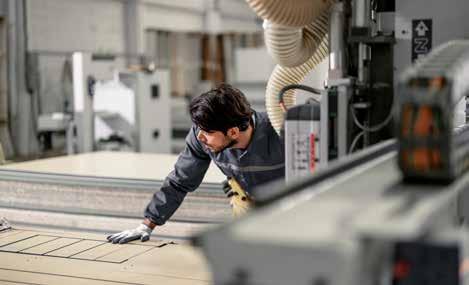
Your people are your greatest asset, bringing a wealth of knowledge, experience, and creativity to the table— qualities that cannot be replicated by machines alone. At the heart of every manufacturing process are the people who design, operate, and maintain the automated systems. There are also those who have a deep understanding of materials, skilled techniques, and customer preferences that make their expertise invaluable. With a human resources lens, there are a few things to remember when bringing automation to your operations.
One of the key challenges in integrating the human element into automated production is the fear of job displacement. However, automation should be seen as a tool to enhance workers’ capabilities rather than replacing them. By automat-
ing repetitive tasks, individuals can focus on more complex and value-added activities, such as design customization, quality control, and customer engagement. To fully leverage the potential of automation, companies must foster a culture of innovation and continuous learning. This includes providing training and upskilling opportunities for workers to adapt to new technologies and processes. Automation also allows for increasing training to learn how to use this equipment to their advantage, such as data collection, customizing software, and understanding machine capabilities. By investing in your employees, companies can ensure a smooth transition to automated production while maxi-
mizing the benefits of human-machine collaboration.
Moreover, automation should not only improve efficiency but also enhance the overall employee experience. By involving the team in the design and implementation of automated systems, companies can create a sense of ownership and pride in their work. This, in turn, can lead to higher job satisfaction and increased productivity. Fostering a culture of innovation and continuous improvement will ensure that your workforce remains engaged and motivated, driving the success of your automated production. This can be facilitated by dedicating time through team meetings to discuss gaps the team may be facing and new ideas that will help improve their day-today tasks.
In conclusion, prioritizing the human element in automation is about more than just maximizing technology’s benefits. It’s about nurturing a workforce with diverse perspectives and talents. By recognizing the unique contributions of human workers and fostering a culture of innovation, companies can achieve a harmonious balance between man and machine. This approach leads to increased efficiency, quality products, and enhanced competitiveness in the Industry 4.0 era, all while creating a workplace that is engaging, supportive, and reflective of the diverse world in which we live.
Amrita Bhogal is the 3rd generation at Sunrise Kitchens, with a focus on People and Culture. She is leading change through lean principles and continues to strengthen culture through values and behaviors.
38 WOOD INDUSTRY SUMMER 2024 FEATURE



Ready to get started? SCAN HERE CABINET VISION – ALPHACAM VORTEK SPACES – WEB-CAB End-to-end solutions for your impeccably crafted manufacturing business. PLANITCANADA.CA
fuel innovation and foster growth within your team.
are relentless in your quest for efficiency.
see opportunities where others see barriers.
look beyond the now and aim to scale your business. Visit us at Hexagon Booth B4513 Let’s talk about growing your business now, and into the future. You don’t watch the next big thing happen. You make it happen. Software for your well-oiled machine 2024
You
You
You
You
WHAT IS COMBUSTIBLE DUST
And why should you care?
By Jamison Scott, President of Air Handling Systems
According to CCOHS, “Combustible dust is any material (finely divided solid particles) that has the ability disperse in air and catch fire and explode when exposed to an ignition source. Combustible dust may include materials that are in the physical states of powders, flakes, fines, fibers, etc.”
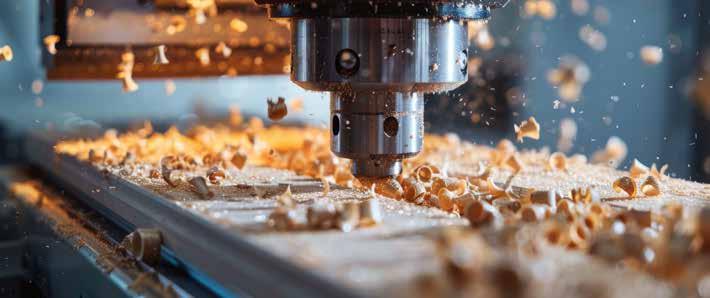
According to ICC, “Combustible dust can cause compounds to ignite, creating flash fires, or even cause explosions.” Additionally, NFPA defines combustible dust as “a finely divided combustible particulate solid that presents a flash fire or explosion hazard when suspended in air or the process-specific oxidizing medium over a range of concentrations. (NFPA 652-2019). However, it is not simply defining a fine dust particle but also determining what makes a dust particle combust. Essential factors include but are not limited to, particle size, particle shape, particle aging, and the actual environment. Additionally, CCOHS notes, “In order to determine the level of risk from combustible dust, a risk assessment should be completed by a competent person (e.g., safety engineer, industrial/occupational hygienist, etc.).”
CCOHS (Canadian Centre for Occupational Health and Safety), a government agency, along with ICC (International Code Council), IFC (International Fire Code), and NFPA (National Fire Protection Association) are consensus standards, meaning they create the guidelines various government agencies and organizations use when monitoring or regulating various activities. Consensus standards are not laws unto themselves but the standards used by many law enforcement agencies, and in many cases by an AHJ (Authority Having Jurisdiction). The Authority Having Jurisdiction is typically a local, provincial, federal, or other regional government official, including, but not limited to, a fire marshal, building inspector, labor department, health department, other local or provincial authorities, or insurance inspector.
Insurance Companies can be a valuable resource as they have data sheets that “describe recommended preventive measures to reduce the frequency of combustible dust explosions, as well as protection features to minimize damage from a combustible dust explosion.”
The health and safety of employees are paramount when it comes to combustible dust and it is common sense that too much fugitive dust is an issue. Beyond the health concerns of breathing fugitive dust, the safety of employees from a possible explosion must be understood. The first reported combustible dust explosion was over 300 years ago in a flour facility. Fast-forward to Babine Forest Products sawmill in Burns Lake, B.C., which killed two and injured 19, to the Lakeland Mills sawmill in Prince George, B.A., which also killed two and
40 WOOD INDUSTRY SUMMER 2024 COLUMN
injured 22 people, along with countless other explosions throughout the world.
To create the perfect storm for a combustible dust explosion, the three elements of fire must be met: fuel, which is the dust; ignition, which can be in the form of a spark; and oxygen AND two additional elements are needed to create an actual explosion: dispersion and confinement. These five elements fuel, ignition, oxygen, dispersion and confinement create the perfect setup for an explosion.
How do you know if you have too much dust? Look at your machinery or floor surfaces. If you cannot see the actual color of your floor or machine, you have too much dust. For example, if you have a green machine and cannot see the color, you should clean the area and then determine the source of the dust.
Prevention measures include everything from properly functioning dust collection systems with additional features, depending on size, including but not limited to abort gates, spark detec-
tion systems, and explosion protection venting/suppression to housekeeping. Housekeeping is one of your first lines of defense and should be proactive rather than reactive. If you see dust, do not ignore it! Clean it up and examine the sources—seal openings to prevent the release of fugitive dust. Inspect the entire workplace; consider overhead beams, electrical cable trays, lighting fixtures, and “invisible” areas above suspended ceilings. These are all areas where fugitive dust will settle and, if left unchecked, could be the sources of secondary dust explosions as occurred with the Imperial Sugar Explosion.
Most importantly, employees should be educated on the hazards and preven-
tive measures surrounding combustible dust. “Safe work habits are developed and do not occur naturally,” as stated in NFPA 652 (A.9.5.2.1), reminds us of the importance of training. Do the workers know what to do? Have they read the operating procedures? Do they understand the procedures? Have they been tested? Has the training been documented? Entities like CCOHS, ICC, IFC, CCOHS, NFPA, AHJ, Insurance Co., and most importantly, the safety of the employees and the workplace, should be the driving force behind your vigilance and self-regulation to prevent combustible dust issue and a possible explosion.
Jamison J. Scott, President of Air Handling Systems in Connecticut, combines business acumen with educational influence as an adjunct Professor at Quinnipiac University. Renowned for his expertise in combustible dust management, Jamison is a prominent speaker and author, contributing to several trade publications and international seminars. His leadership and commitment to industry excellence significantly impact global standards and safety in woodworking.
















































www.woodindustry.ca 41 VISIT US IN BOOTH #6773 to see our fully automated line featuring our Easy Paper cefl afi nishing.com FCS patented system: less than 20 sec. for color switch Automatic paper alignment system Automatically defined trajectories High transfer efficiency “Airsphere” Plenum: patented system for perfect extraction of overspray Self-cleaning system less WE ARE HERE
COLUMN Ultimax®Ligno Mirka 1-855-234-6385sales.ca@mirka.comDedicatedtothefinish. All-newabrasiveforwoodworking LEARNMORE
ACCESSIBLE DESIGN
For Baby Boomers & the Aging Population
By Lucy Traetto, Senior Sales & Marketing Representative, Blum Canada ltd.
The cabinetry industry in Canada plays a significant role in the country’s economy, contributing to manufacturing and creating job opportunities nationwide.
Factors such as population growth, urbanization, housing construction, and remodeling activities have driven the demand for cabinetry in recent years. The market trend towards open concept living spaces, customized designs, and environmentally friendly materials has also influenced the cabinetry industry in Canada.
The ongoing trends in housing, construction, and consumer demand for quality and customized cabinetry products are expected to drive the steady growth of the industry. It is crucial to differentiate products and solutions to meet the needs of the demographic with the most disposable income, particularly baby boomers, who are investing in home renovations to make their

living spaces more comfortable, functional, and valuable as they age.
What products and solutions can differentiate you from the others? What solutions will enhance and improve quality of living in the home? Who is the demographic that will, in the immediate future, benefit from functionality and ergonomics in the home?
Baby boomers have the most disposable income which means they can spend money on home renovations. They are the largest group of homeowners making these renovations, accounting for 41% of total spending on home renovations in the country. Baby boomers have the desire to make their homes more comfortable and functional as they age, as well as to increase the value of their properties. Additionally, many baby boomers are retiring or approaching retirement and are using their savings to improve their living spaces for their golden years. As of 2021, seniors make up around 17% of the Canadian population, and this proportion is expected to continue to increase in the coming years.
Knowledge is power. Being aware of this type of information will allow us to create cabinetry that is not only beautiful but that will be functional, ergonomically friendly, safe for the homeowners as well as anybody that visits that home. It is also a great selling feature when that house is sold.
Designing cabinets for baby boomers and the aging population in general involves consideration of functionality, ergonomics, accessibility, and aesthetics tailored to their needs and preferences. Here are some tips that encompass these principles:
42 WOOD INDUSTRY SUMMER 2024 COLUMN
When a kitchen is laid out in zones, all storage goods are in the area they need to be used and are organized. This makes kitchens more efficient, ensures good workflow and improves quality of living.
1. Designing zone cabinets: this means that you build cabinets around the storage goods of the individuals living in that home. This will ensure that all their storage goods will be in the area that they are needed.
2. Accessibility: Ensure cabinets are easy to reach without excessive bending or stretching. Opt for full extension drawers instead of deep cabinets, allowing easy access to items at the back as well as the ability to keep things nice and organized.
3. Upper Cabinets: Doors in upper cabinets can be obstructions. In addition, they can be dangerous if the user is bent down to access something out of a base cabinet, stands up and hits their head on the corner of the door. Instead, think of using lift systems as they go up and stay up. This is ideal when unloading a dishwasher as you can put glasses, cups, and dishes away in one fluid motion because of the unrestricted access on all sides. Lift systems also provide brightness into the cabinet unlike doors.
4. Soft-Close Mechanisms: install soft-close hinges, drawer slides, and lift systems to prevent slamming, making cabinets quieter and safer, especially for aging users.
5. Toe Kick Drawers: Falls in the home are the leading cause of injury for older adults therefore it is important to incorporate safe solutions to reach high places. An example of this would be to add a toe-kick drawer which not only add height but also increases usable storage space as there is a drawer under the step.
6. Accessible Hardware: Install cabinet hardware that is easy to grip and operate, such as large handles where you can fit at least 2-3 fingers. This ensures that an individual with arthritis or limited dexterity can grip and pull with their hand or a cane.
7. Handless Fronts: Bulky handles that stick out can often get caught on pockets or can bruise and elder person as their skin becomes very thin and delicate. Solutions such as touch to open doors, drawers, and lift systems allow us to eliminate the handles which not only mitigates injury but also gives the room a nice clean look.
8. Cabinet Heights: It is important to
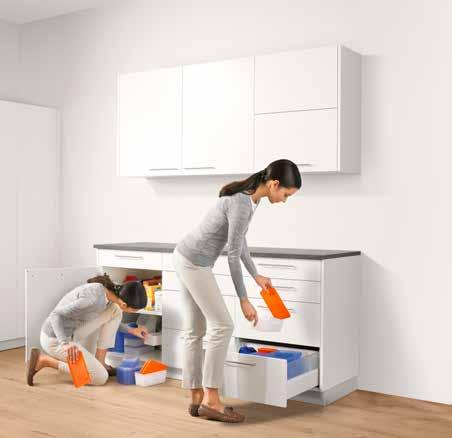

www.woodindustry.ca 43
COLUMN
TOP: Full extension drawers in base cabinets offer many ergonomic advantages. The contents inside can viewed easily from the top, significantly improving access. With doors in bases cabinets, one if forced to bend and reach. BOTTOM: Upper cabinets with doors are obstructions and make it difficult to navigate around the kitchen. When lift systems are used, the doors go up and out of the way to making it easy to put your dishes away and access is available from all sides.

ensure that cabinets are installed at accessible heights and locations to allow users to reach and use them easily. It may not always make sense to put cabinets all the way to the ceiling if they are not accessible. The money that can be saved there can be put towards the functionality in the cabinets below the counter. Adding organization, ensuring the drawers are deep all the way
around, having enclosed sides of the drawers so items do not slip through — these are all great ways to improve function and the overall experience for the user.
9. Clear Visibility: Using lighting under cabinets or inside them is important as this improves visibility, making it easier for baby boomers and others with vision impairment to see contents, especially in dimly lit areas.
10. Consultation and Feedback: Lastly, it is important to engage with baby boomer and aging clients throughout the design process to understand their specific needs, preferences, and any challenges they may face in the kitchen, bathroom, or other living space. This will lead to more tailored and satisfactory cabinet solutions. Incorporating these principles will not only result in timeless designs but, most importantly, will enhance the quality of living and safety in homes, especially for baby boomers and individuals with limitations or disabilities.
Lucy Traetto works as a Senior Sales & Marketing Representative at Blum Canada Ltd, bringing homes to life with safety and accessibility. With her expertise as a Certified Aging-in-Place Specialist (CAPS) and Certified Living in Place Professional (CLIPP), she focuses on products and designs that make every living space more inclusive and user-friendly for all ages.



HIGH QUALITY EDGE BANDING


No problem for EdgePro. This coating head is precisely adjustable, repeatable in adhesive application, and clean in cut-off. robatech.com/edgepro
44 WOOD INDUSTRY SUMMER 2024
COLUMN
KILN-DRIED SOFTWOOD IN EASTERN WHITE PINE, AROMATIC CEDAR, AND DOUGLAS FIR IN A VARIETY OF THICKNESSES AND WIDTHS Craftsmen Hardwoods Inc. PO Box 280 Drayton, ON N0G 1P0 519.638.3380 | sales@craftsmenhardwoods.com craftsmenhardwoods.com Distributors of
A pull-out shelf that locks into places allows you to place heavy objects such as a coffee maker or a mixer without having to lift them off of the counter. They will come out to you, lock in place then can be tucked away when finished using.




MAXIMUM RELIABILITY AT AN EVERYDAY PRICE




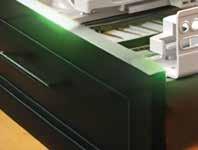













Introducing Progressa, the newest family of concealed undermount slides by Salice

Meet and exceed ANSI Grade 1 specifications ensuring unmatched durability, and unwavering performance.



Utilize true progressive action and synchronization to smoothly operate under dynamic loads of 45 kg (Progressa) to 70 kg (Progressa+).

The fully integrated fluid-dampening device ensures an enhanced smooth glide and exceptional deceleration during closing.



Made for 13 mm (1/2”) and 16 mm (5/8”) drawer side material thicknesses




www.salicecanada.com
WHY DIGITAL PRINTING
May Just be the Solution to an Industry Dilemma
By David Smith, President of Garnica’s North American Division

In an era increasingly influenced by calls for sustainable practices, advancements in AI, and soaring inflation rates, the race for companies to adapt is both a necessity and a challenge of unprecedented proportion.
As industries worldwide grapple with the growing pressures of these influential factors, digital printing emerges as a transformative technology in the manufacturing sector, specifically wood production. This article explores how digital printing is not only meeting the demands of modern design but also driving forward eco-friendly practices in an industry historically reliant on natural resources.
SUSTAINABLE SOLUTIONS
Manufacturers worldwide are increasingly recognizing the importance of adopting eco-friendly practices while leveraging cutting-edge technologies to streamline operations and enhance product offerings. As such, digital printing technologies which offer the aesthetic appeal of traditional hardwood while promoting environmental preservation are emerging as a viable solution.
One company that has already successfully implemented digital printing into their framework is Garnica, a leading manufacturer of premium sustainable plywood. Their revolutionary digital print technology recreates highly coveted veneer designs on a poplar plywood platform sourced from fast-growing European tree farms. This innovative approach not only delivers stunning and realistic aesthetics but also addresses the industry’s growing demand for sustainable materials while promoting responsible forestry practices. By opting for this unique alternative, architects and designers can reduce their reliance on exotic hardwood, thereby contributing to the conservation of precious natural resources.
QUALITY AND SCALABILITY
One of the most compelling features of digital printing on plywood is the exceptional consistency and quality, transcending traditional material limitations.
46 WOOD INDUSTRY SUMMER 2024 COLUMN
The technology also enables scalable production, offering unparalleled flexibility for projects of any size or scope, from large applications in commercial projects to smaller, custom orders. This scalability enhances the versatility of the product, helping to meet diverse market needs efficiently.
LIMITLESS POTENTIAL
Highly durable and customizable, digitally printed plywood is well suited for a range of projects including furniture and décor, kitchen cabinetry, walls, and ceilings. This technology enables architects and designers the flexibility to create bespoke designs, from intricate patterns to personalized branding elements, expanding creative boundaries.

COST EFFICIENT SOLUTIONS IN AN UNCERTAIN ECONOMY
As inflation rates soar across North America, architects, designers, and their clients are eager to embrace sustainable building materials that will help reduce expenses. Digital printing offers a viable solution by streamlining the manufacturing process and eliminating the need for costly hardwood veneers, offering a more affordable solution without compromising on quality or performance.
LOOKING AHEAD
Digital printing represents a groundbreaking step forward in the journey toward sustainability, technology, and cost efficiency in manufacturing. As the industry continues to evolve, digital printing stands at the forefront, championing sustainability, efficiency, and innovation. This technology is setting new standards for what’s possible in design and production, paving the way for a more sustainable and creative future that challenges precedent and pushes boundaries.
David Smith is the President of Garnica’s North American Division and brings over 28 years of industry expertise to his role. Prior to joining Garnica, he held senior positions at EGGER Group and Arclin USA, later founding The David Smith Group, a consulting firm focused on sustainable building materials.










www.woodindustry.ca 47
COLUMN
MURPHY MEANS MORE QUALITY Setting QUALITY and innovation standards since 1943. No One Gives You More! N.R. MURPHY LT D U S T C OLL E C T OR 430 Franklin Blvd., Cambridge, ON N1R 8G6 E-mail: 4nodust@nrmurphy (519) 621-6210 www.nrmurphy.com VISIT US AT BOOTH B5528 ChoiceMachineryGroup com American Machinery Brands • Customized solutions to fit your operation • Entry level laminating lines to fully integrated systems • Domestic Parts and Service Dependable Customer Service Visit us at booth: B7800 • Clamp Tables Pocket Cutters • Line Drills Horizontal Borers • Edge Sanders
MANUFACTURERS WORLDWIDE ARE INCREASINGLY RECOGNIZING THE IMPORTANCE OF ADOPTING ECO-FRIENDLY PRACTICES WHILE LEVERAGING CUTTING-EDGE TECHNOLOGIES.
CONSTRUCTION AND CONSUMPTION
Q1 2024 Housing Report and Insights
By Tyler Holt, Editor of Wood Industry Magazine
This report delves into the trends of housing starts in Canada during the first quarter of 2024, focusing on their impact on the secondary wood manufacturing industry. We examine the shifts in residential construction, from single-family homes to larger multi-unit complexes, to understand how these changes affect the demand for wood products.

For stakeholders such as cabinet manufacturers, furniture makers, and millwork businesses, keeping pace with these trends is crucial. It helps them anticipate the need for raw materials and adjust their production and inventory strategies effectively. Our goal with this analysis is
to provide clear, actionable insights that will assist these businesses in navigating the market’s fluctuations and making informed decisions. This way, they can better align their operational strategies with the evolving needs of the construction sector.
HOUSING STARTS IN Q1 2024
In the first quarter of 2024, Canada’s housing starts showed a dynamic yet fluctuating trend. January commenced with a total seasonally adjusted annual rate (SAAR) of housing starts at 223,589 units, marking a 10% decrease from De-
48 WOOD INDUSTRY SUMMER 2024 COLUMN
cember 2023’s 248,968 units. This downturn continued into February, though at a slower pace, before the trend slightly reversed in March with housing starts picking up, yet still not reaching the heights of the previous months.
Comparatively, when looking at the same period in the previous year, there was a noticeable variability. For instance, despite a month-to-month decline in January 2024, the year-over-year data for the same month showed an increase of 13% in the actual number of housing starts across urban centers with populations over 10,000, which was primarily driven by a surge in multi-unit starts.
Key factors influencing these trends included economic conditions such as GDP growth rates, employment levels, and notably, the shifts in interest rates which are closely tied to housing market activities. Government policies, especially those related to housing and urban development, also played a significant role in shaping these trends.
These fluctuations are visually represented through charts and graphs within this section, illustrating both the monthly SAAR and actual starts to provide a clear, comprehensive view of the market’s movements. This visual representation, coupled with detailed statistical analysis, offers a solid foundation for understanding the current state of the housing starts landscape in Canada.
SECONDARY WOOD MANUFACTURING INDUSTRY IMPACT
The fluctuating housing starts in the first quarter of 2024 have direct implications for the secondary wood manufacturing industry. For instance, the robust increase in multi-unit housing starts, particularly noted in urban areas like Toronto, directly correlates with heightened demand for wood products utilized in cabinetry and millwork. These products are essential components of apartment buildings and condominiums, which saw significant construction boosts.
Conversely, the variability in singledetached housing starts affects demand differently. While these starts require more extensive woodworking for indi-

vidual units, such as custom furniture and elaborate millwork, the slowdown in March highlights a potential decrease in demand for such bespoke items. Therefore, businesses involved in manufacturing wood products for single-detached homes might have experienced a temporary dip in demand.
Amidst these shifts, several challenges emerge, notably supply chain disruptions and the volatility of wood prices, which can significantly impact production costs and profit margins. For example, sudden increases in multi-unit housing starts can strain raw material supplies, leading to longer lead times and increased costs.
However, these challenges also present opportunities. Wood manufacturers can leverage trends in housing starts to better forecast demand and adjust their inventory management strategies accordingly. Diversification of product lines to include both components for high-volume multiunit developments and bespoke items for single-detached homes can also help stabilize revenue streams.
By adapting production planning and expanding product offerings, businesses in the secondary wood manufacturing industry can not only mitigate risks associated with market volatility but also capitalize on emergent opportunities driven by evolving housing start trends.
REGIONAL INSIGHTS AND SPECIFIC IMPACTS
The regional analysis of housing starts in major Canadian cities—Toronto, Vancouver, and Montreal—reveals distinct trends that uniquely influence the local secondary wood manufacturing industries.
Toronto: The city witnessed a significant rise in housing starts, especially in the multi-unit sector, which surged by 179% compared to the previous quarter. This dramatic increase has bolstered demand for wood products used in multi-unit residential buildings, such as engineered wood panels and prefabricated wood components. Local wood manufacturers have responded by scaling up production capabilities to meet the burgeoning demand, navigating challenges like supply chain delays and raw material shortages due to increased consumption.
Vancouver: In contrast to Toronto, Vancouver experienced a mixed trend with a notable 55% decline in multi-unit housing starts early in the quarter, followed by a recovery. This volatility has created uncertainty for wood manufacturers, impacting their inventory management and production scheduling. Despite these challenges, the demand for luxury wood products remains
www.woodindustry.ca 49
COLUMN
TORONTO: Qualifying for a mortgage became harder in 2023, and affordability challenges are expected to persist (Toronto CMA). Source: CMHC.

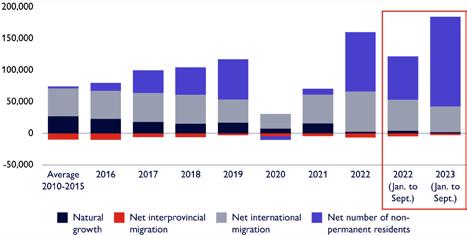
robust, driven by Vancouver’s high-end single-detached housing market, which requires custom woodworking and highquality finishes.
Montreal: Housing starts in Montreal showed a moderate decrease, particularly affecting the multi-unit segment. This has led to reduced demand for massproduced wood products like framing lumber and plywood. However, the decline has also opened opportunities for wood manufacturers to explore niche markets, such as renovation and retrofitting existing housing units, which can be less sensitive to new housing market fluctuations.
These regional disparities underscore the need for wood manufacturers to remain agile, adapting their business strategies to align with local market conditions and construction trends. By leveraging regional insights, businesses can better
position themselves to take advantage of local demand fluctuations, optimizing their operations to cater to specific market needs while mitigating risks associated with regional economic variability.
FUTURE OUTLOOK AND STRATEGIC RECOMMENDATIONS
As we look towards 2024-2026, the housing starts landscape is anticipated to navigate through periods of contraction followed by recovery. Initially, the market may face a downturn in 2024, influenced largely by the residual effects of heightened interest rates. A rebound is expected in the subsequent years as these rates stabilize and supportive government policies come into effect, enhancing construction activity.
Strategic Recommendations:
1. Scaling Operations: Flexibility in operations will be crucial. For regions
experiencing growth, such as areas with increased multi-unit construction, businesses should consider expanding production capabilities. Conversely, in regions bracing for a downturn, it would be wise to streamline operations to maintain efficiency and minimize costs.
2. Leveraging Technology: Implementing advanced manufacturing technologies like CNC machinery and automation can significantly boost efficiency, reduce waste, and enhance adaptability to changing market demands. This strategic investment not only improves operational efficiency but also positions companies to swiftly adapt to market shifts.
3. Diversification: Diversifying product offerings can mitigate risks associated with the housing market’s cyclical nature. Exploring opportunities in commercial construction or renovation sectors may provide more stable demand during residential market downturns.
4. Policy Impact: Government policies are set to significantly influence the construction industry. Forthcoming initiatives aimed at promoting affordable housing or sustainable building practices are expected to spur demand for specific wood products, such as certified sustainable wood or innovative materials like crosslaminated timber. Staying abreast of these policies and participating in industry advocacy can help businesses align themselves with emerging trends and influence policy decisions that affect the sector.
The future of the housing market and its impact on the secondary wood manufacturing industry hinges on a complex interplay of market forces and policy decisions. By strategically adapting operations, investing in technology, and diversifying product lines, companies can not only survive but thrive in this evolving landscape. Keeping a close eye on government policies and economic indicators will also be essential for timely and effective strategic planning.
50 WOOD INDUSTRY SUMMER 2024
COLUMN
VANCOUVER: Sales in South Fraser will make up an increasingly large share of the resale market in Metro Vancouver. Source: CMHC.
MONTREAL: Estimates of population growth components, province of Quebec - International migration and non-permanent residents support population growth in Quebec. Source: CMHC
JOIN US AT IWF ATLANTA
A Hub of Innovation and Inspiration
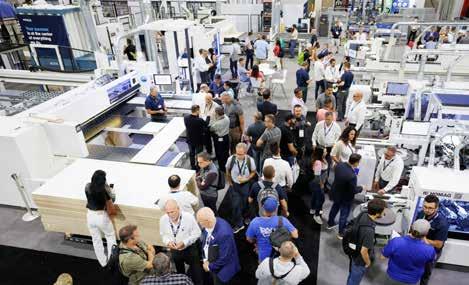
Hello to all our readers and fellow woodworking enthusiasts! As your trusted source for everything in the woodworking sector, we’re thrilled to invite you to join us at this year’s International Woodworking Fair (IWF) in Atlanta. We’ll be right in the middle of the action at booth C2816, and we can’t wait to connect with you!
WHAT’S HAPPENING AT IWF?
The buzz around this year’s IWF is incredible, and it’s shaping up to be one of the biggest gatherings yet. According to IWF Atlanta, “With more than 1,000 exhibitors contracted and attendee registrations pacing well ahead of plan, IWF 2024 is on track for a robust showing August 6—9 at Atlanta’s Georgia World Congress Center. The show will present North American woodworking’s largest product mix in Halls A, B, B-C and C collectively housing thousands of lines and designs—including many exclusive U.S. introductions. IWF exhibitors will access a large and diverse attendee base drawn from across the U.S. and around the world.” This year promises new products, services, and enhancements like expanded registration facilities and early Hall A opening hours, making it an event you won’t want to miss.
DIVE INTO THE WORKSHOPS AND LIVE DEMOS
From hands-on workshops offering practical knowledge and skills, such as “Advanced CNC Techniques,” to live demos showcasing the capabilities of new tools and machinery, there’s an incredible range of activities to engage with. These sessions provide invaluable insights and are a perfect opportunity to witness innovation in action.
SPOTLIGHT ON KEYNOTES AND LEARNING
The heart of the fair beats in the lecture halls, where visionaries like Will Sampson, Lynn Thomson, and Marc Sanderson will share their expertise and insights on the future of woodworking and manufacturing:
• CNC Automation Insights with Will Sampson: Will’s workshop on “CNC Automation for Beginners” is essential for anyone entering or considering the

CNC field, providing a comprehensive overview of tools, software, and strategies for success.
• Lean Manufacturing Revolution by Lynn Thomson and Brad Cairns: Don’t miss this in-depth look at lean principles during the QUANTUM Lean Symposium, focusing on efficiency and productivity improvements across industries.
• Strategic HR Management with Marc Sanderson and Cassey Gibson: Explore modern strategies for recruitment and retention that are crucial in today’s competitive job market in their transformative session.
WHY YOU SHOULDN’T MISS IWF
With its extensive array of exhibitors, a large and diverse attendee base, and a schedule packed with valuable sessions, IWF Atlanta is more than just a trade show; it’s a comprehensive platform for discovery, learning, and advancement in the woodworking industry. It’s where professionals from all over come together to share ideas, challenges, and innovations. So, whether you’re a longtime reader or new to our community, we’re excited to meet you at booth C2816. Let’s make this IWF a memorable one, filled with new connections, learning, and plenty of woodworking fun. See you in Atlanta!
www.woodindustry.ca 51
EVENTS

New from Blum: AVENOTS HKi
With AVENTOS HKi, you can have complete design freedom with our new lift system that fully integrates into the side panel of the cabinet. AVENTOS HKi is invisible, and when opened, the visible parts of the hinge arm are in sleek onyx black.
PRODUCT PREVIEW

The system is so nimble that it can be used on cabinets with a side panel thickness of only 16mm — yet giving you the freedom to create doors 600mm high and up to 1800mm wide. Visit Blum at Booth #C1863.
Fimal P450AX Sliding Table Saw
The Fimal P450AX Sliding Table Saw is a saw blade unit, with a long shaft, runs vertically along ground bars. Stability and lack of vibration are ensured by the considerable distance between the bearings and the long shaft. The sliding system adopted on the new carriage, with large diameter bearings that roll along tempered and ground prismatic tracks, provides excellent smoothness and ± 0.05 mm straight cutting along the whole carriage stroke.

The speed change is very quick and easy because it can be simply executed through an opening that is above the working table.
Visit Taurus Craco/ Fimal at booth #B7811
Laminating Systems for ANY size shop
Evans Midwest
Evans Midwest provides complete panel laminating solutions, which can be customized to fit various requirements, from entry-level to fully integrated single-point control systems. Evans Midwest can accommodate operations of any size, reflecting a combination of engineering and experience aimed at optimizing laminating lines for specific applications.
Evans Midwest’s intermediate laminating system consists of an infeed scissor lift with gravity conveyor, Layup Table with Laminate Rack, Heated Roller Press, and an outfeed conveyor with scissor lift. The system is capable of handling material sizes ranging from 24”-61” wide x 36”-145” long and thickness ranging from 1/4“- 2” thick.
Visit Evans Midwest | Choice Machinery Group Booth #B7800

Cantek RapidEdge Pro Automatic Edgebander
Our top-of-theline edgebander is designed to make edge banding a breeze. With its advanced technology and user-friendly interface, the RapidEdge Pro can apply edge banding to your projects in record time, without sacrificing quality or accuracy. Rapidly change over from various edge thicknesses and finishes right from the control panel. Its compact size and easy-to-maneuver design make the RapidEdge Pro the ideal edgebanding solution for use in any workshop or manufacturing setting. See it in action at IWF 2024.

Visit Akhurst Machinery / Cantek America / Leadermac USA at Booth #B6553
Stromab FAST500 MATRIX
High-Speed Automatic Push Feed Crosscut Saw
The Stromab FAST500 MATRIX is a straight cutoff saw with an innovative electronic push feed system and controlled axis. It has been constructed to be highly efficient and increase production with up to 40% more production over the standard model. This state-ofthe-art machine blends the reliability of a pneumatic cut-off saw with an ascending saw blade with an electronic push-feed system pusher system, driven by a precision and high-speed rack and pinion guide system. Whether you are simply cutting to length or looking to defecting and optimizing, the FAST500 Matrix from Stromab is the crosscutting saw solution for you.

Visit Akhurst Machinery / Cantek America / Leadermac USA at Booth #B6553
DOUCET GANTRYX Stacker / Destacker
The GANTRYX is the perfect system for those who want to increase their productivity. It is also designed to overcome lack of space and manpower. This system facilitates the sorting of parts required for production by companies that cut and process wood panels for subsequent gluing, like stair treads and table manufacturers. The GANTRYX, an articulated arm with vacuum grip, automates the handling of the panels at the infeed and outfeed of your moulder or sander. He allows automatic stacking and unstacking in the areas provided for this purpose. Visit Doucet Machineries at Booth #B5535
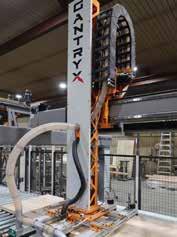
52 WOOD INDUSTRY SUMMER 2024
PRODUCT PREVIEW
HOLZ-HER DYNESTIC 7535: Dynamic 5-axis machining in XXL format

The DYNESTIC 7535 CNC with 5-axis cutting spindle and a 2,200 mm deep grid table is the flagship of the new series with nesting machines made by HOLZ-HER. Even with this huge working depth, the moving stands in solid gantry design ensure utmost precision and optimum cutting results via two synchro drives. The high-flow nesting table ensures optimum vacuum flow and can also be supplied with an intelligent 16-field grid table and softwarecontrolled vacuum control. Double-acting suction pads enable the clamping of doors, staircase components, etc., making this 5-axis CNC machine a real all-rounder with virtually unlimited machining options.
Visit Weinig Holz-Her at Booth #B6035
Introducing Mirka Ultimax Ligno
Introducing Mirka Ultimax Ligno, a groundbreaking wood finishing solution that redefines industry standards. This innovative product features an ‘hourglass’ pattern designed for superior performance on wood substrates, ensuring optimal material removal and surface finish quality. Its ceramic and Blue Fired Alox grains prevent clogging and enhance sanding by directing wood fibers smoothly to extraction holes, maintaining clean abrasive grains for uninterrupted cutting. Additionally, Ultimax Ligno uses environmentally friendly, VOC-free resin and energy-efficient production methods, making it a sustainable choice. Available in a wide range of grits and compatible with Multifit hole patterns for easy alignment, this abrasive meets diverse finishing needs with flexibility and extended durability.
Visit Mirka at Booth #A10427

Macon Bar Bracket Corbel from Osborne
The Macon Bar Bracket Corbel (Part #870531) from Osborne’s most recent product line expansion is a versatile piece, carefully crafted with contemporary stylings in mind, and also farmhouse or traditional builds. This wooden bracket is 12” tall with an 8” depth and 1 3/4” thickness. The simple curved profile features small textural elements at the top and bottom that add a subtle dimension to your shelf, range hood, cabinetry or mantel project. Sanded to 150 grit and ready for you to apply your preferred finish, this corbel is available in a wide range of unfinished wood species including paint grade and stain grade woods.
Visit Osborne Wood Products at Booth #C2022


Step Up to KCD Software’s CNC Commander for Cabinets and Closets
Depth of customization meets lean manufacturing for the ultimate in powerful custom design to manufacturing software.

The KCD Software “CNC Commander” excels with a user-friendly design interface and robust manufacturing engine. Get your CNC machine up and running quickly with KCD Software’s free one-on-one Technical Support. KCD Software also offers traditional manufacturing options for non-CNC Shops. Design, Sell and Build it Easier. Email our sales team at sales@ kcdsoftware.com to learn more about the KCD Software difference in the Cabinet and Closet industry.
Visit KCD Software at Booth # C2040
Nederman SAVE

Nederman SAVE enhances dust collector performance and optimizes air filtration through intelligent airflow control. This comprehensive solution optimizes and enhances the performance of your industrial filtration system, leveraging operational data from your machines to determine the precise amount of air needed for effective dust extraction and safe material transport. This results in significant benefits that include:
• Reduced energy requirements - synchronize fan performance with the real-time needs
• Access to data - monitor machine activity and utilization data
• Reduced maintenance - increased tool and filter life, extended maintenance intervals
• HVAC savings - less airflow required
• Reduced noise - lower fan speeds and less filter cleaning
Visit Nederman at Booth #B4547
Benchtop Pro Variable-Speed HEPA-GFM Dust Collector
Pillar Machinery is excited to announce its new MMTJ Miter Machine! Maximize your shop space with a smaller footprint, more power to process big jobs, more clearance for short parts, more efficient maneuverability, and extra safety guarding. Discover firsthand the transformative power of streamlining your processes and see how our sleeker design can revolutionize your workflow, producing up to 275 doors per 8-hour shift with one operator. The MMTJ is a full 3 Axis CNC machining center, tailored specifically to meet high-volume production requirements for high quality miter joints used in cabinet door manufacturing.
Visit Pillar at Booth #B7921

www.woodindustry.ca 53
30%
As a party to the UN Convention on Biological Diversity and the new GBF (Global Biodiversity Framework), Canada has committed to conserving 30% of Canada’s lands and water by 2030.
Source: Natural Resources Canada
10.8%
In 2022, Quebec’s furniture and related product manufacturing sector’s real GDP rose by 10.8% to $1.632 billion, four times the growth rate of all industries (+2.6%).
Source: jobbank

STRENGTH IN NUMBERS
Our cluster thrives on the collaborative model of sharing best practices, gathering new ideas, and working together. Join us and become part of a dynamic and supportive community dedicated to helping each other succeed.

$51,200 0.4%
Employment in furniture and related product manufacturing accounts for 0.6% of employment in Quebec, compared with 0.4% for all of Canada.
Source: jobbank
5.2%
Canada’s secondary wood manufacturing real GDP increased 5.2% between 2021 and 2022.
Source: Natural Resources Canada
As of 2021, the median annual income of carpenters and cabinetmakers was $51,200.
Source: StatCan
46%
Between 2022 and 2023, British Columbia’s softwood lumber exports experienced a YoY decrease of 46%.
Source: StatCan
7.2%
The Canadian wood manufacturing sector yields an average 7.2% profit margin.
Source: CKCA
54 WOOD INDUSTRY SUMMER 2024
FACTS AND STATS
TO LEARN MORE VISIT www.wmco.ca
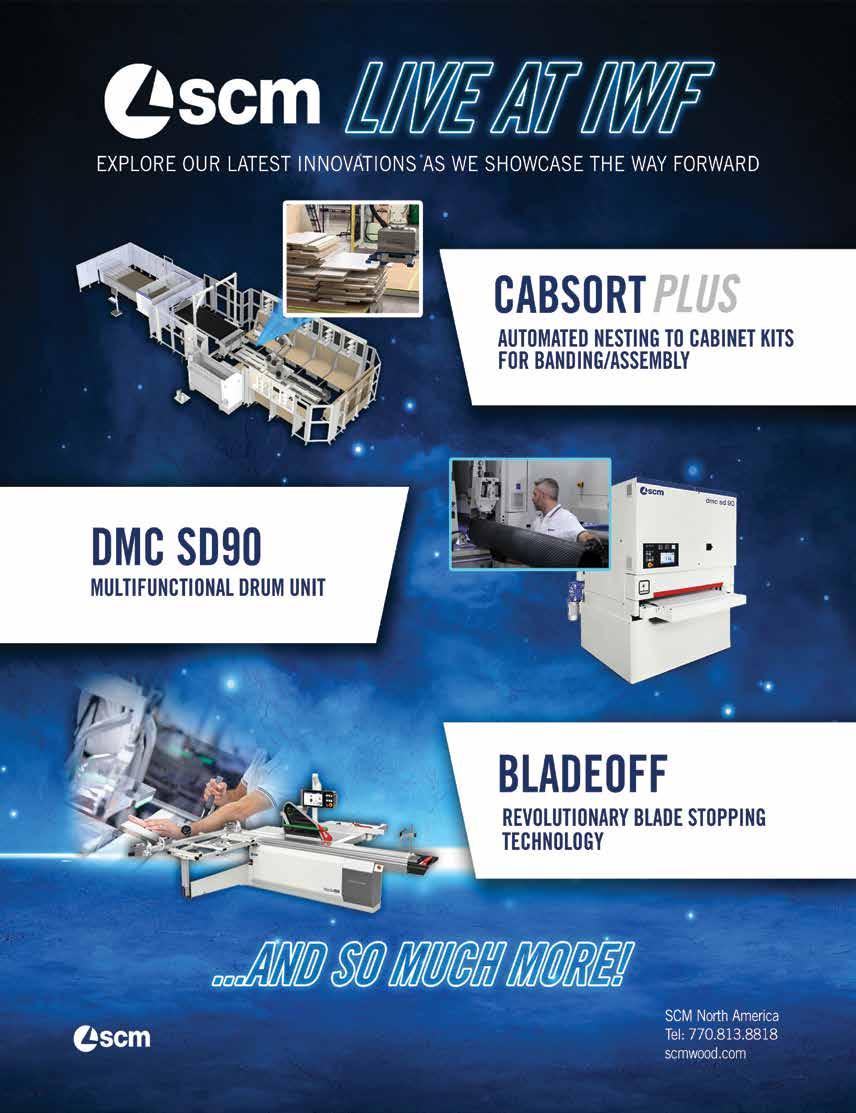
Everything. Except ordinary.

V8
A d r aw er tha t ’s as slim as a pencil .
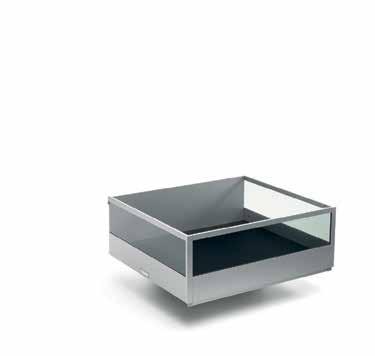
Until recently, the ver y idea of reducing a drawer side to 8 millimetres and, above all, making industrial production commercially viable would have been unthinkable The new slim drawer system not only offers the only 8-millimetre one-piece steel drawer side in the world – Vionaro V8 is also the first pure-metal drawer side with no plastic elements. That produces maximum stability plus longevity and ensures an almost 100 per cent recycling rate
Vionaro V8 Slim Drawer System vionaro-v8.com
Vionaro V8 Slim Drawer System.









 HELLO INDUSTRY PARTNERS,
HELLO INDUSTRY PARTNERS,
























































































 By Tyler Holt, Editor of Wood Industry Magazine
By Tyler Holt, Editor of Wood Industry Magazine

































































































